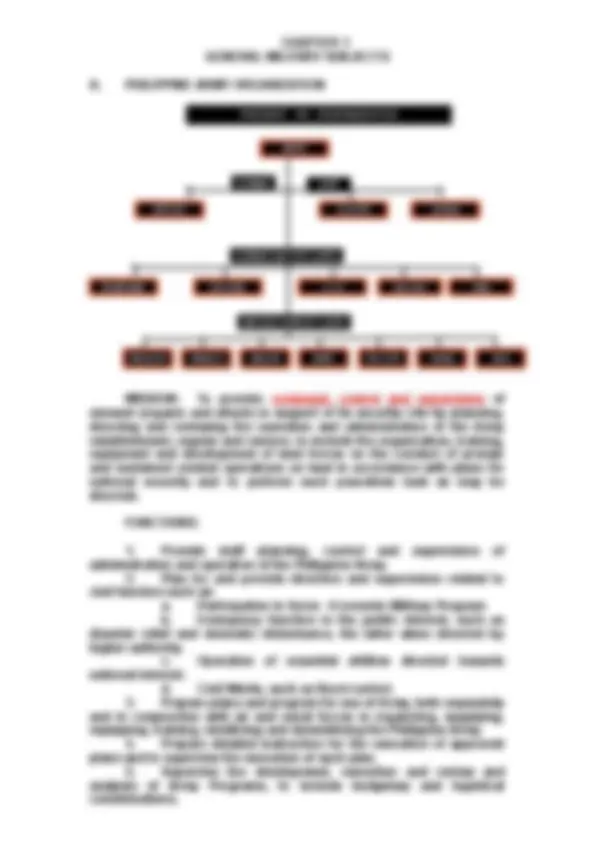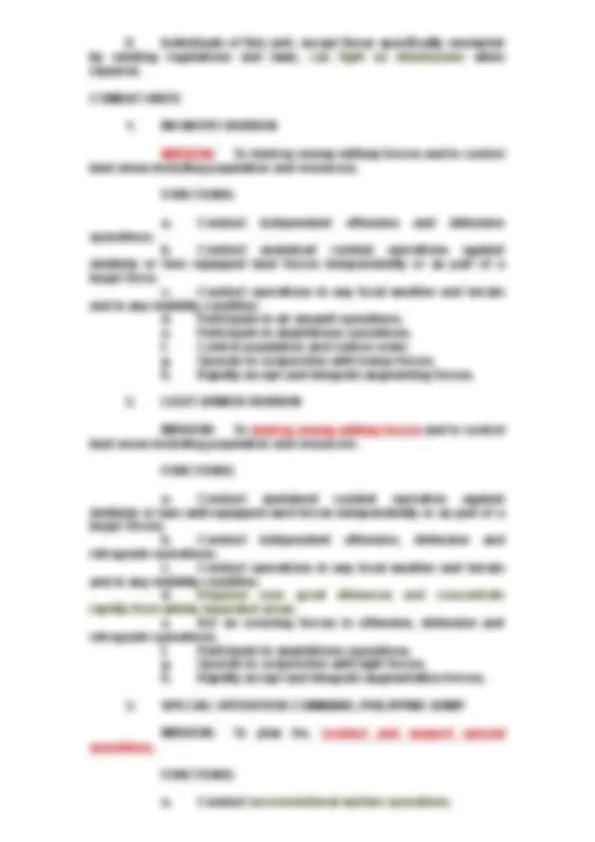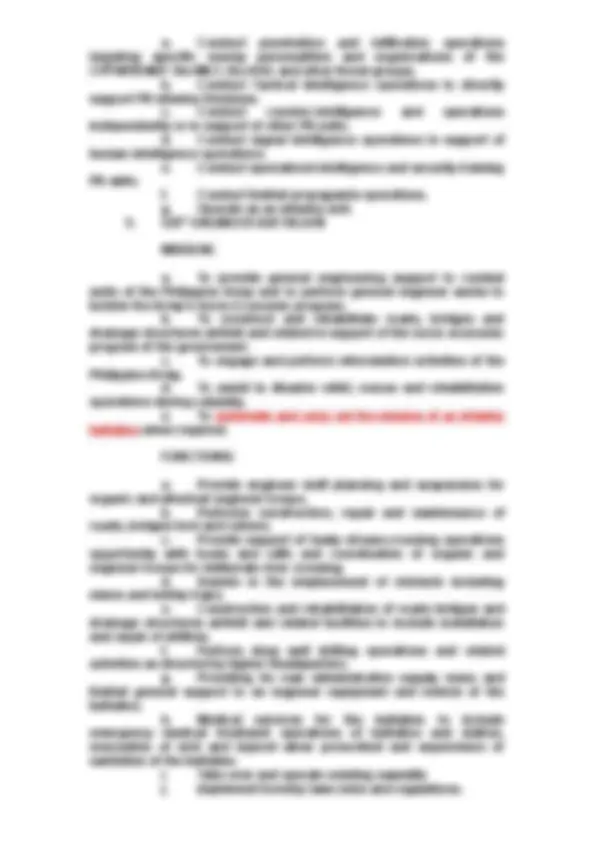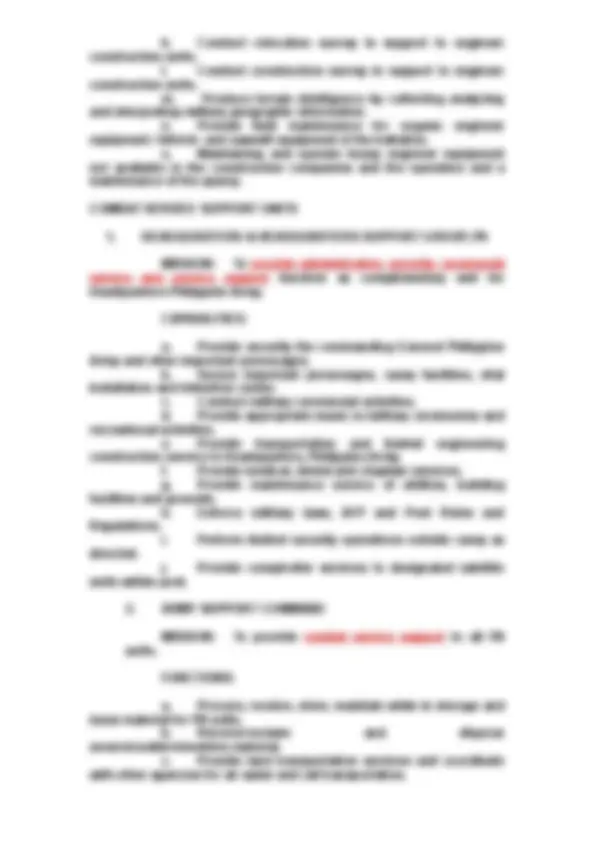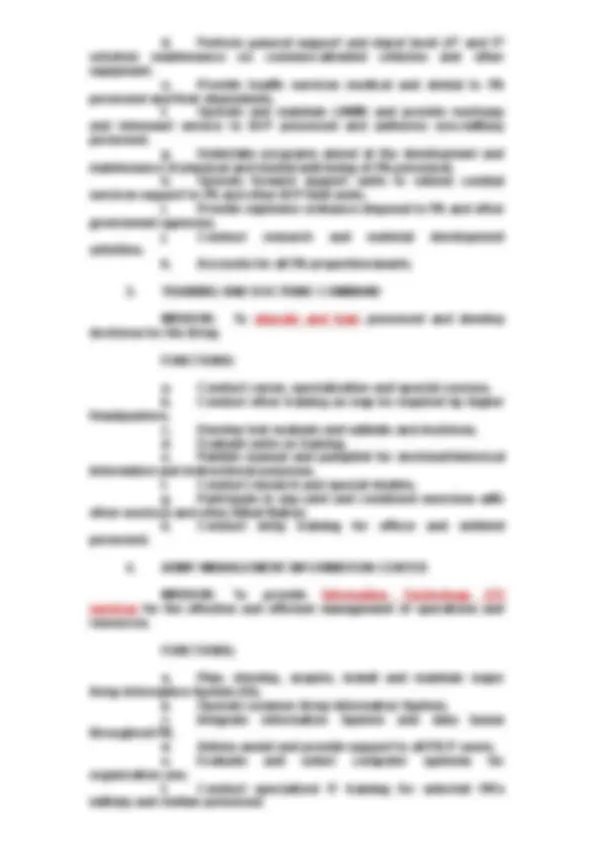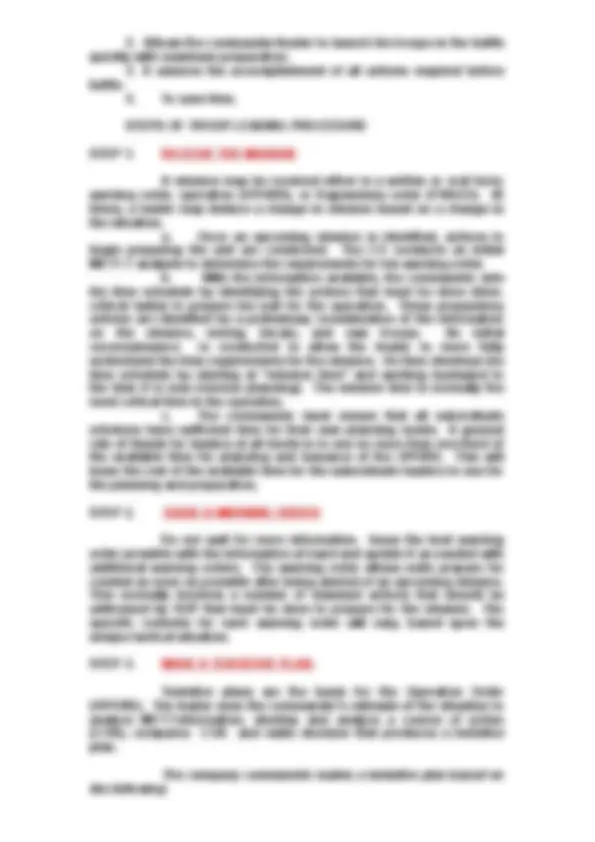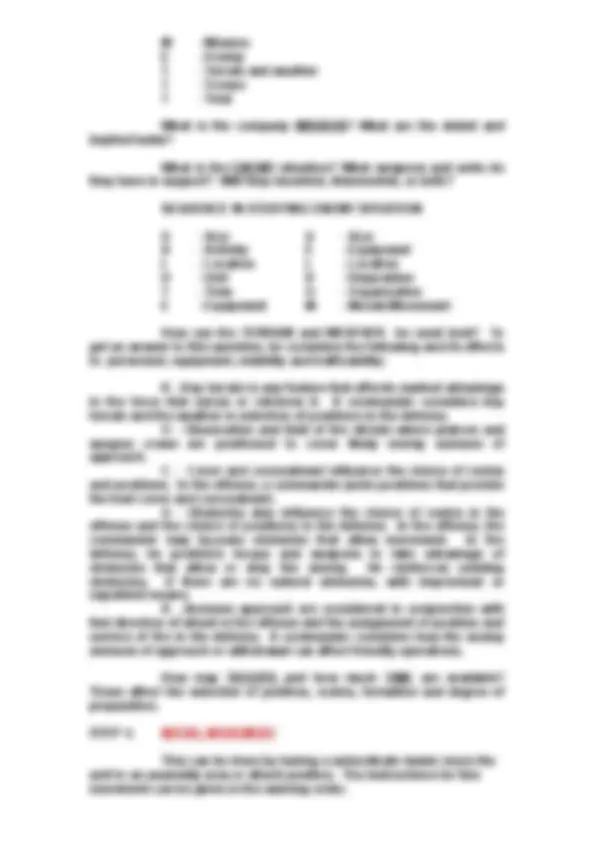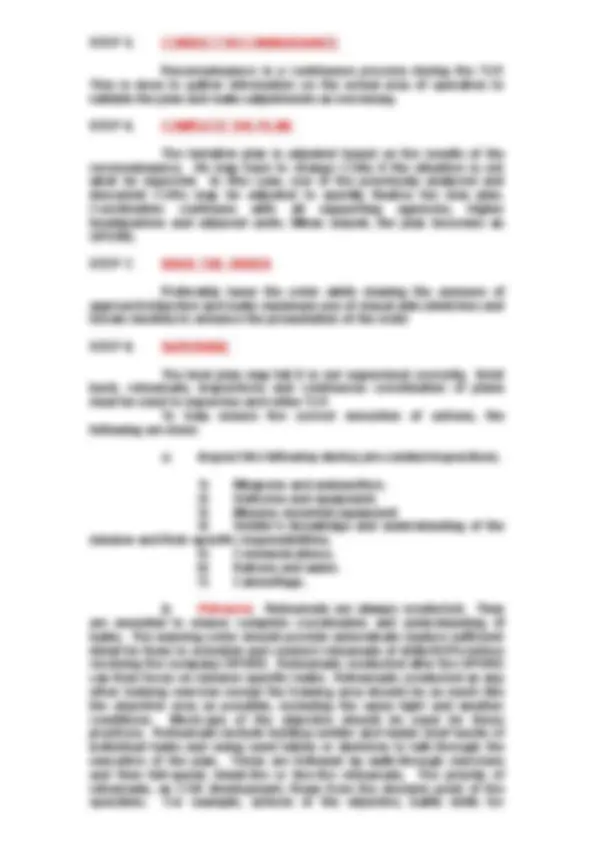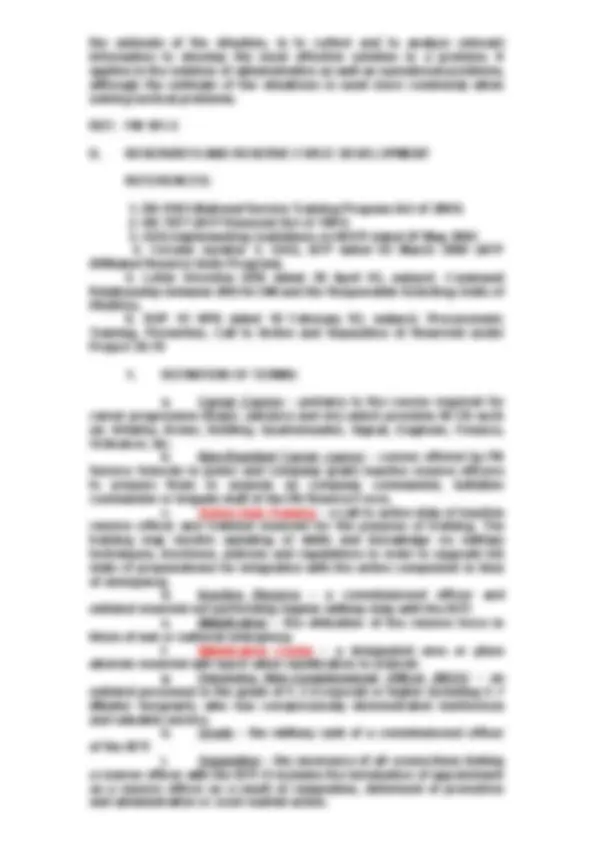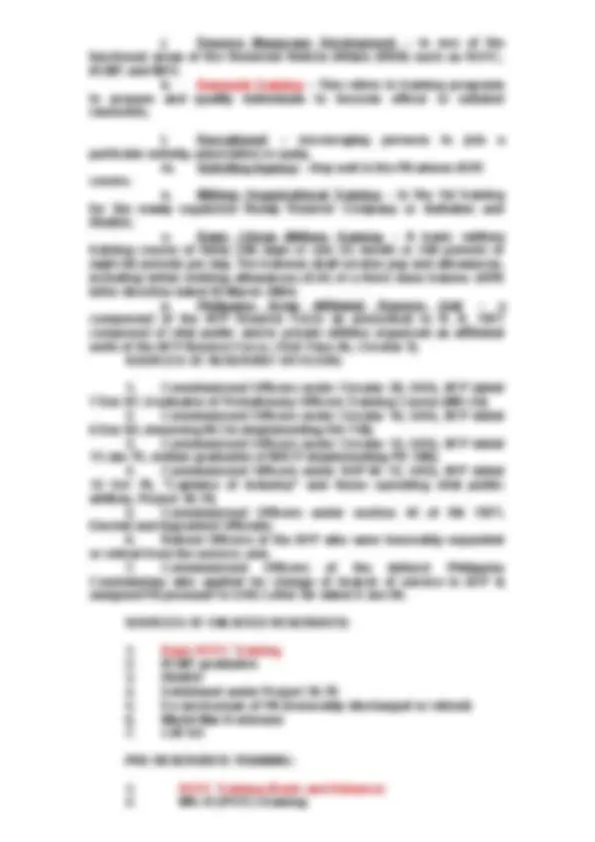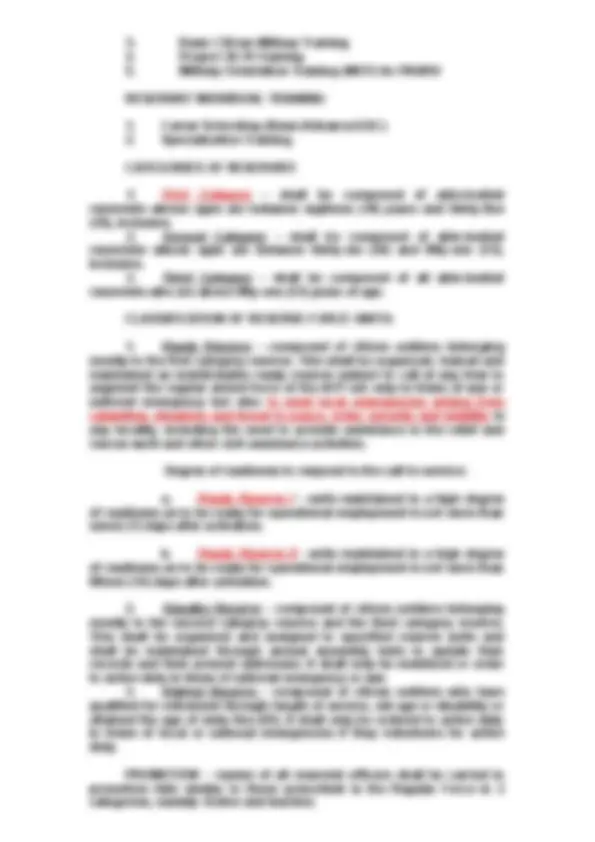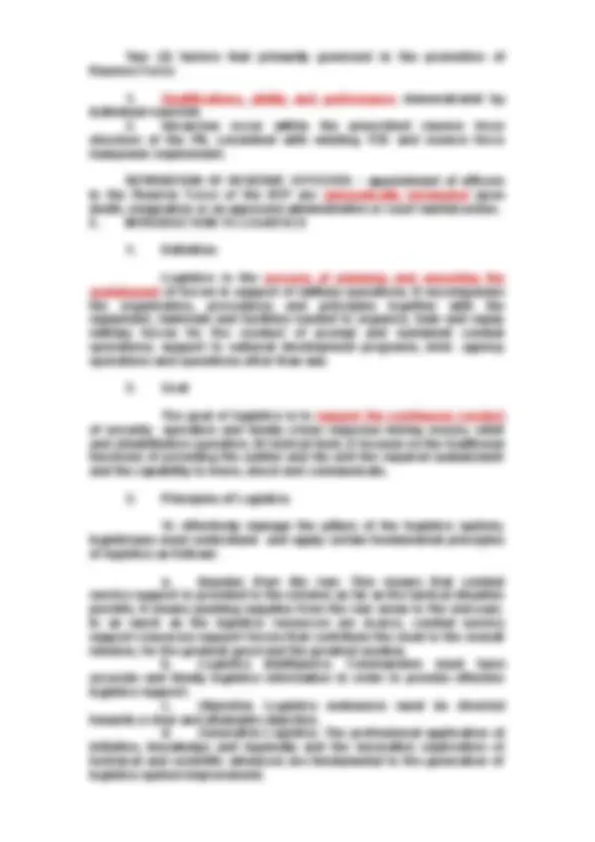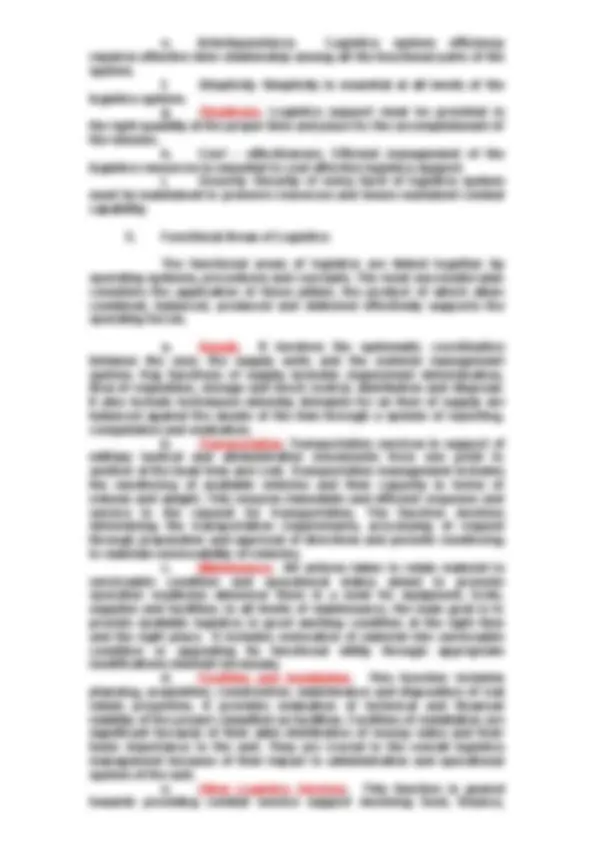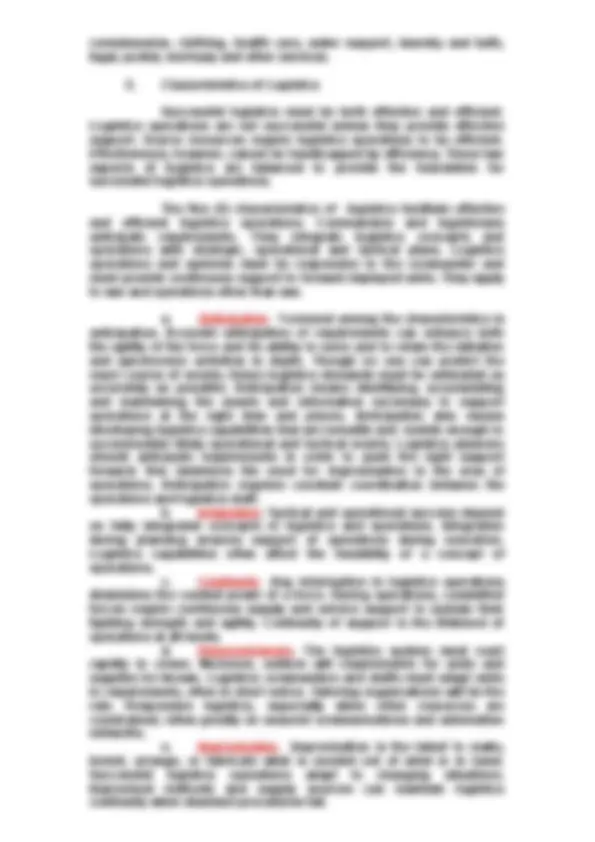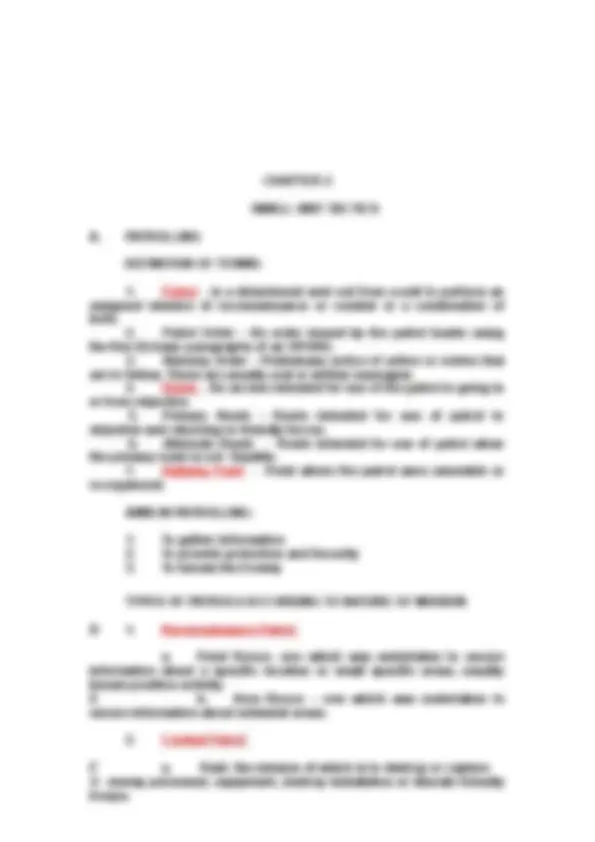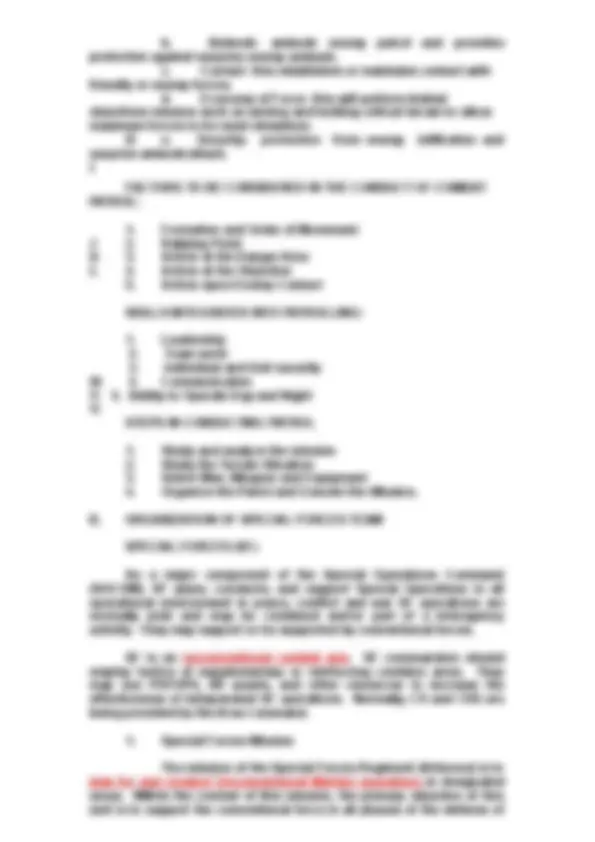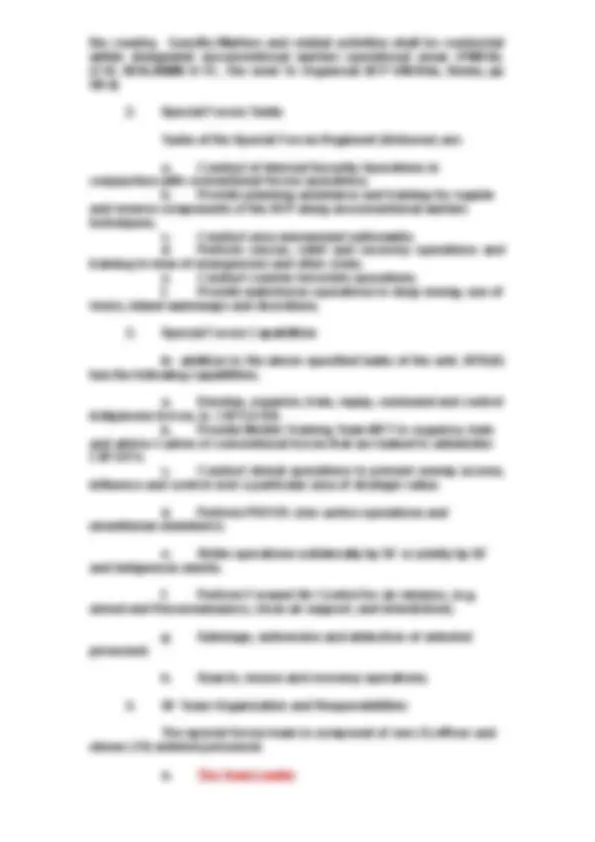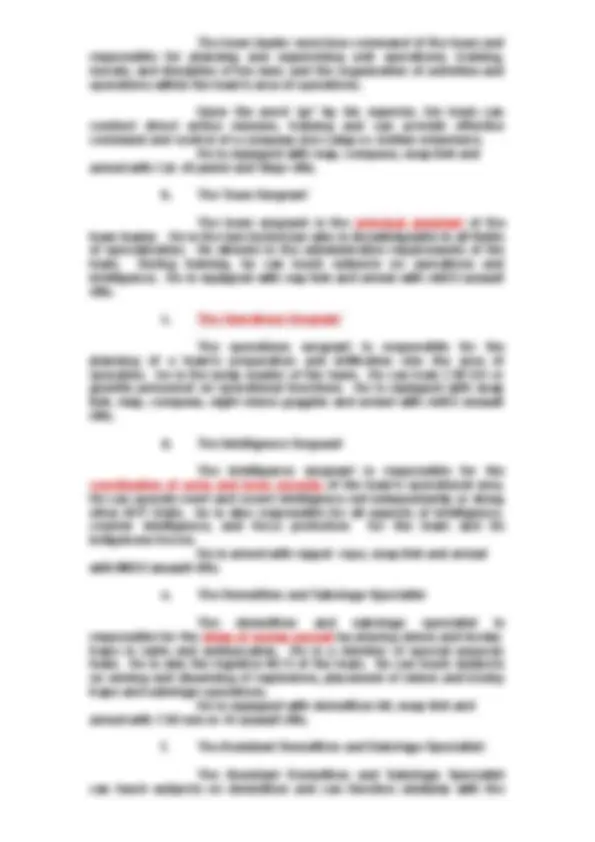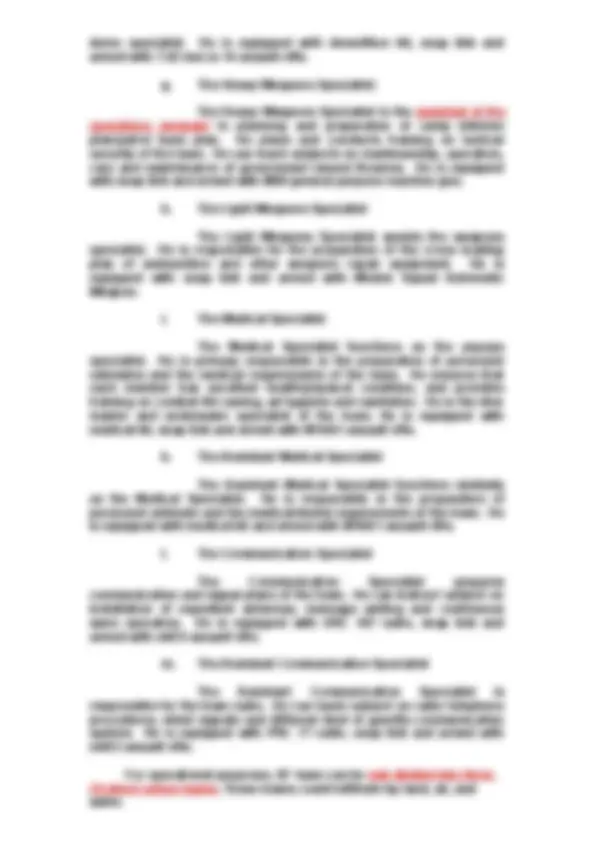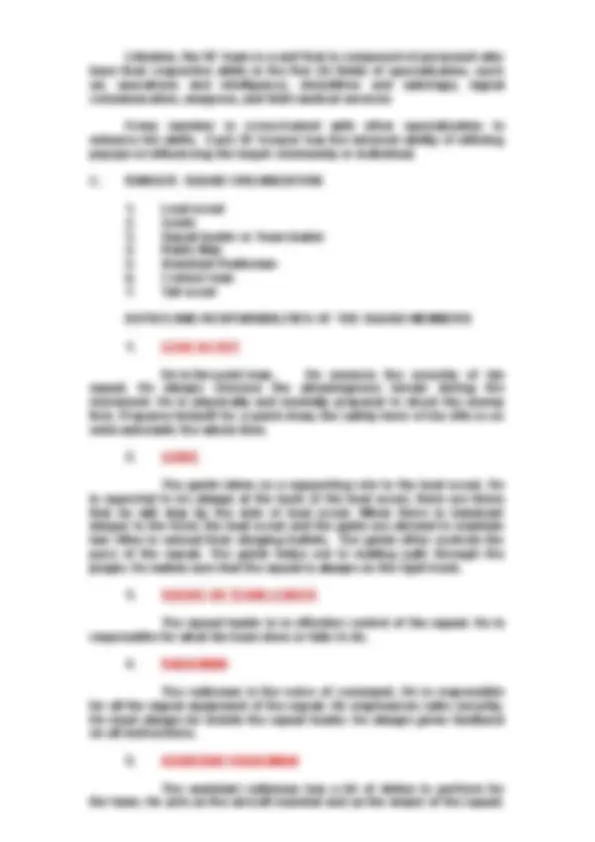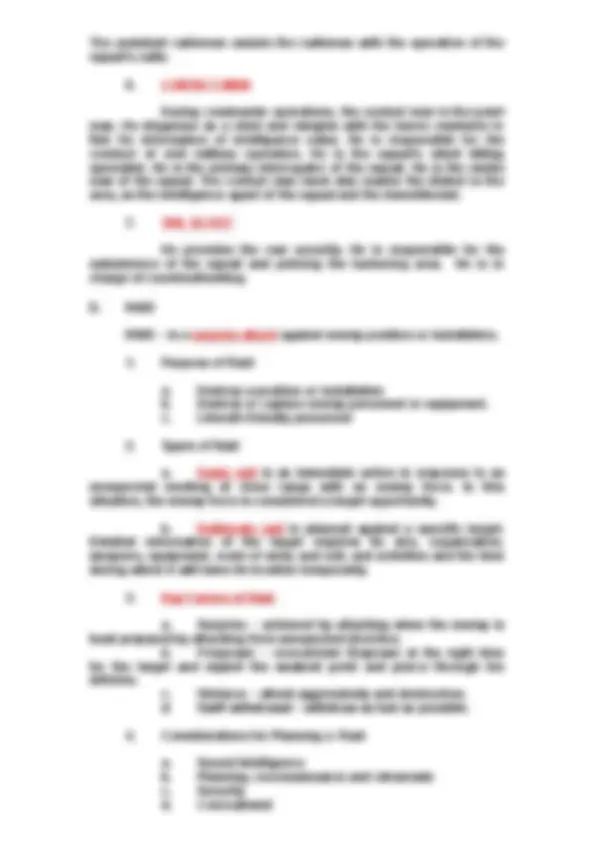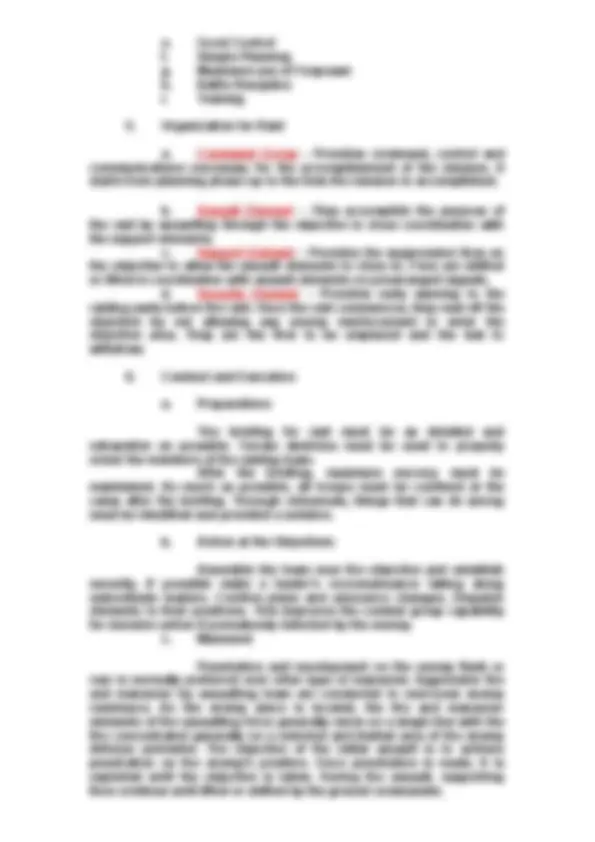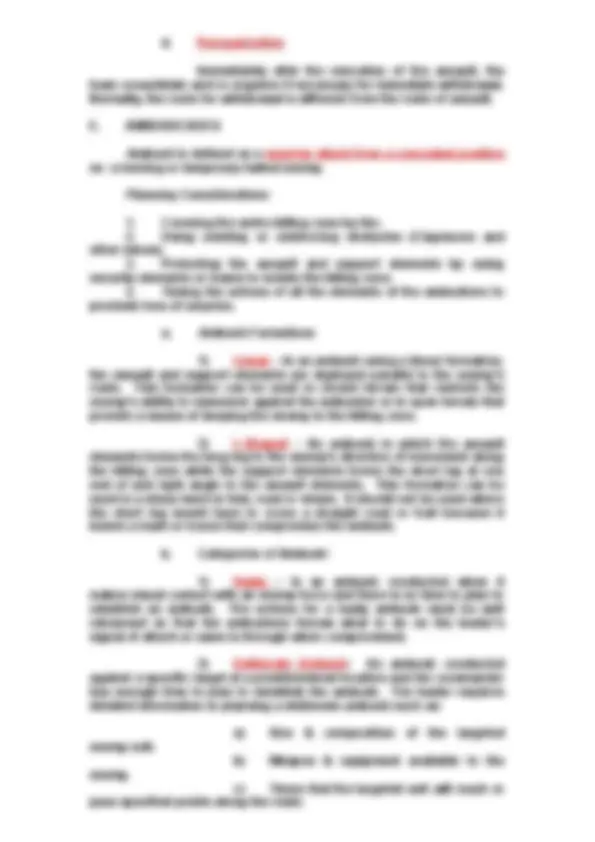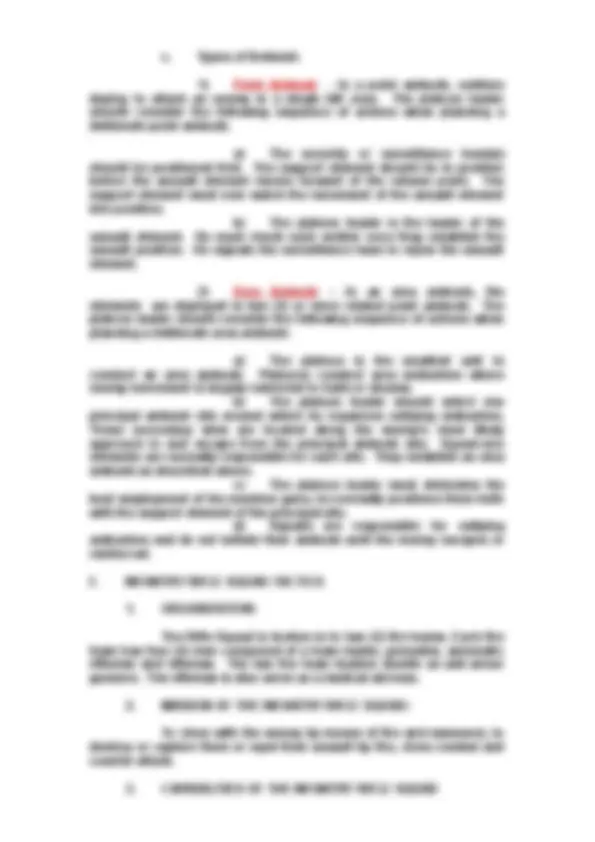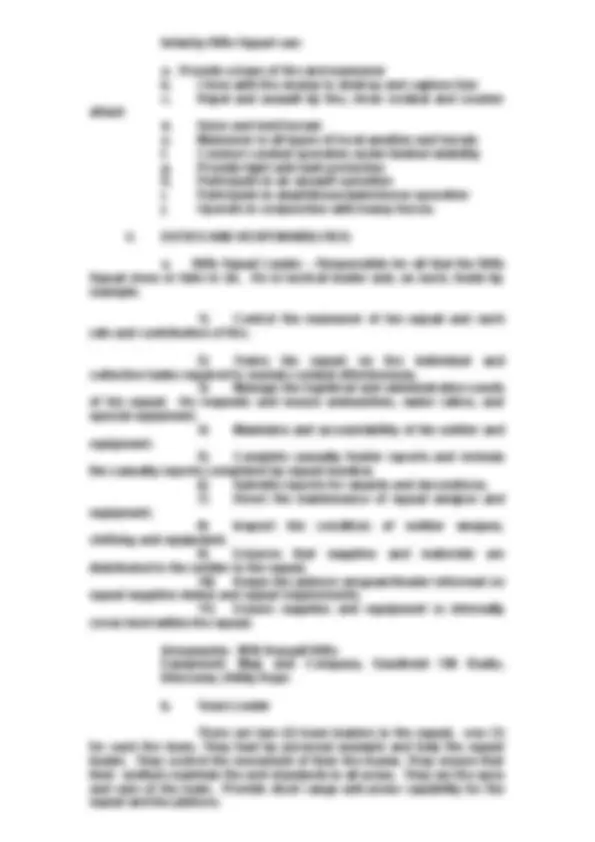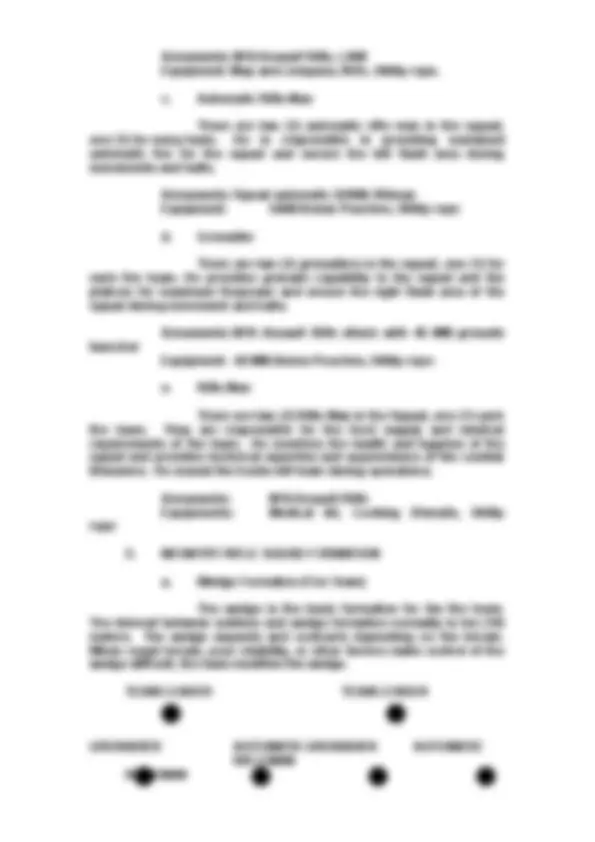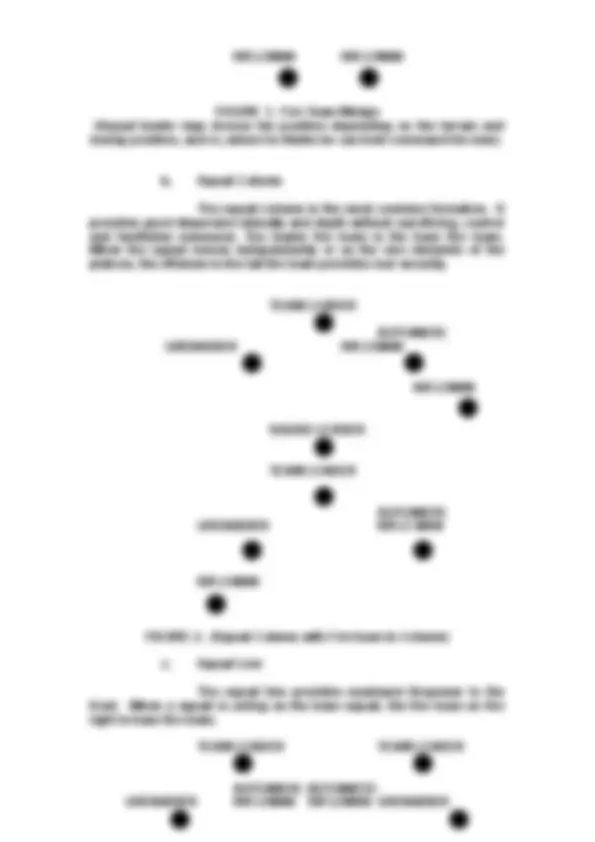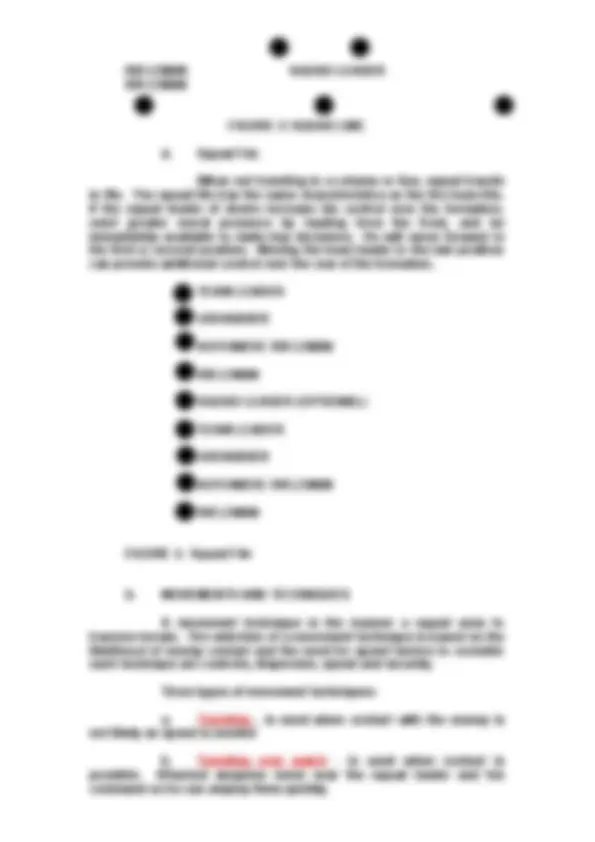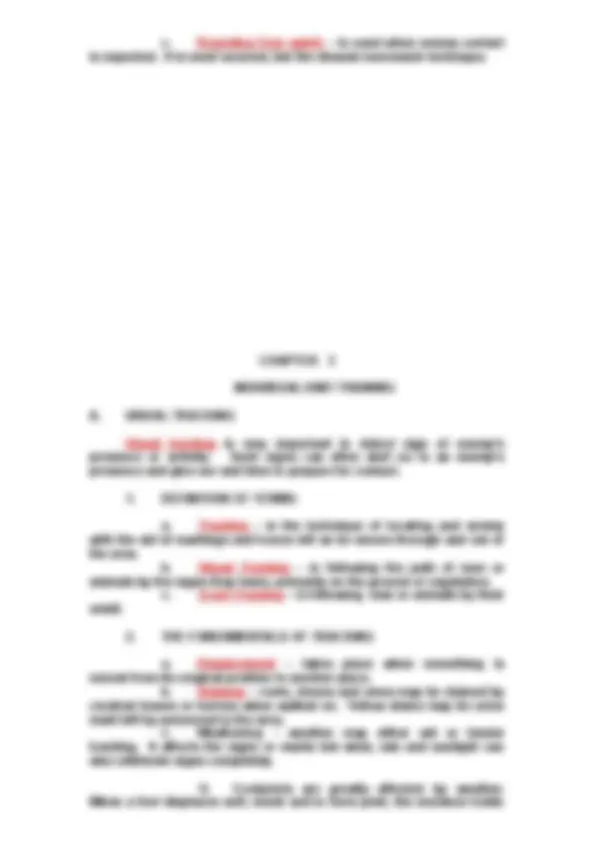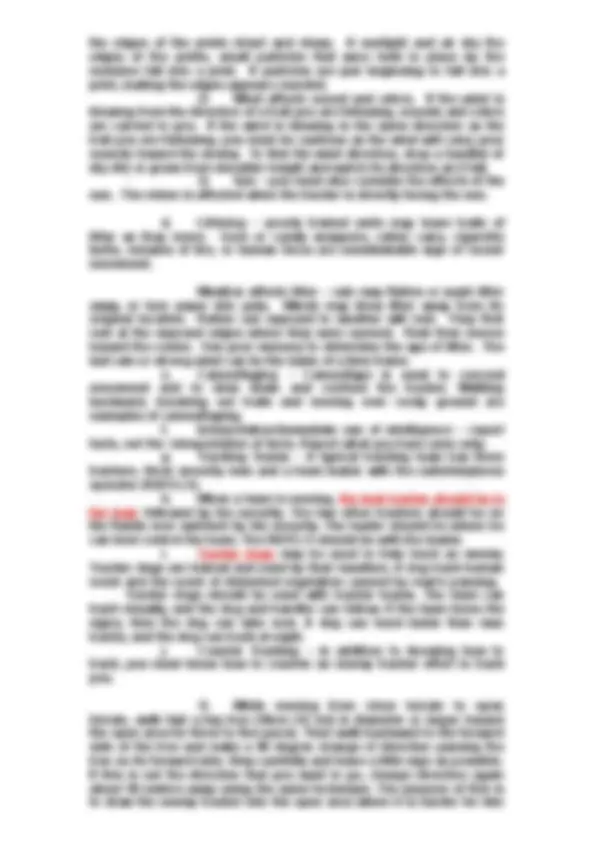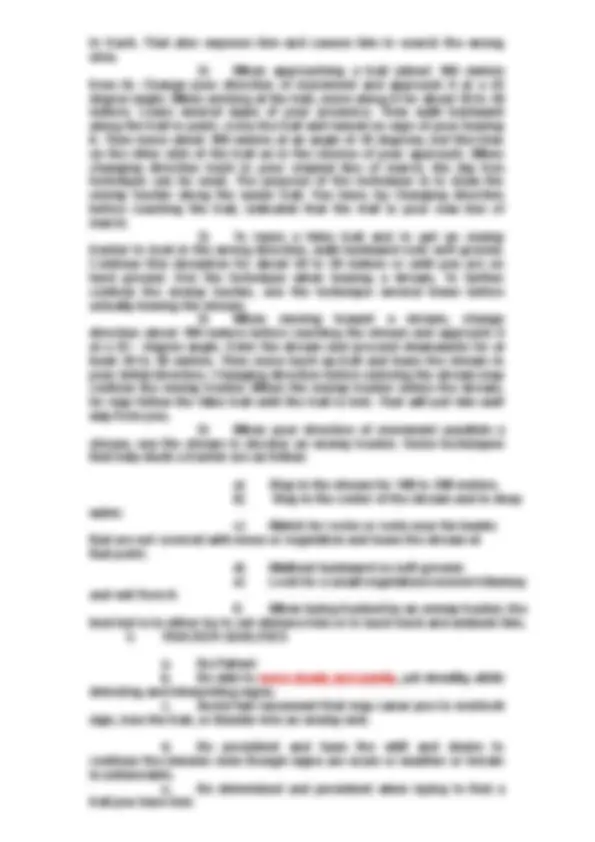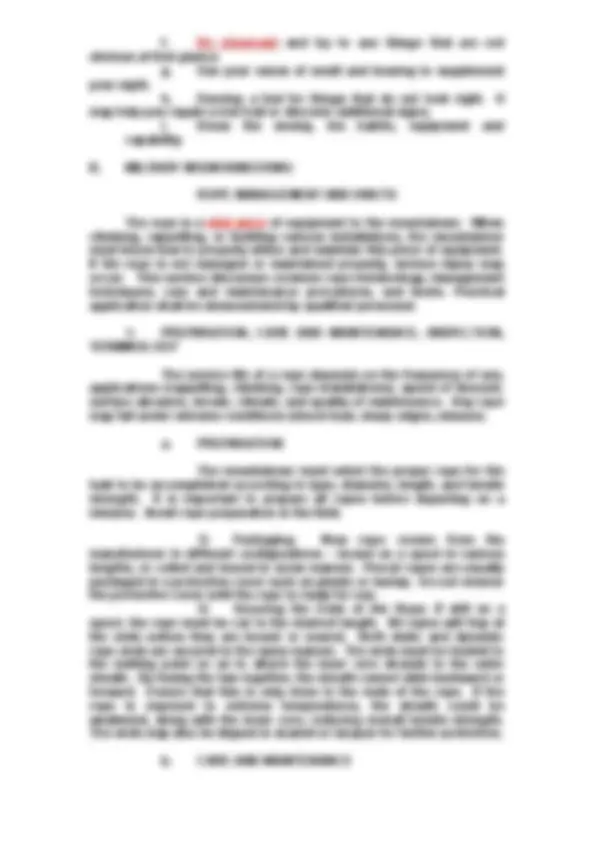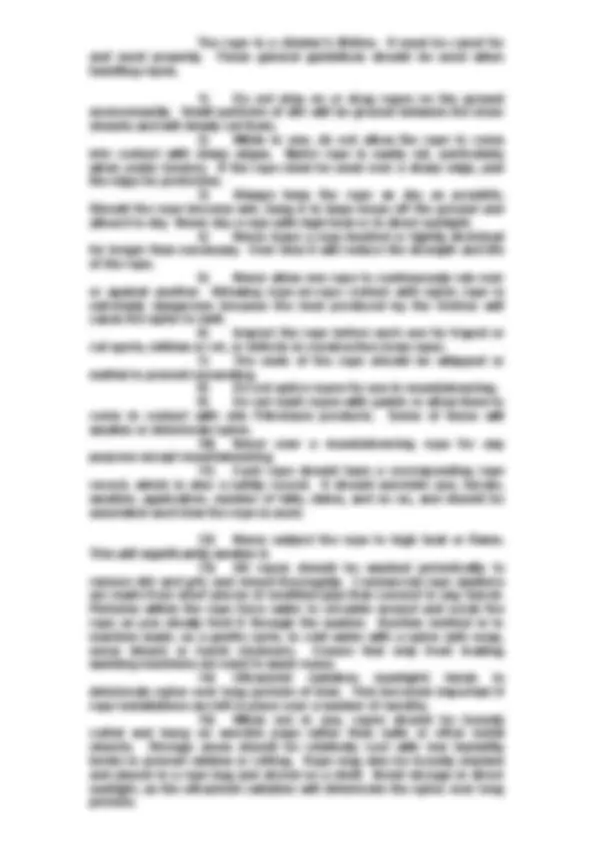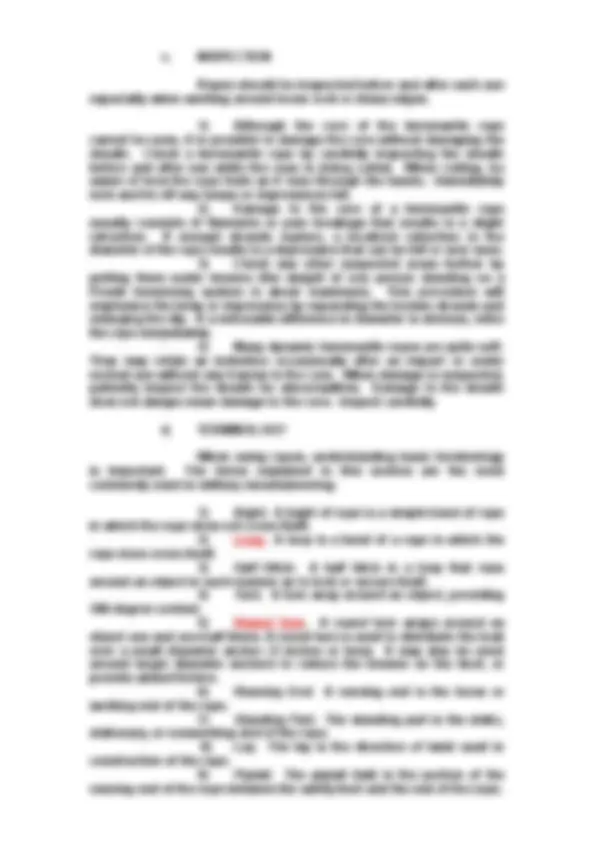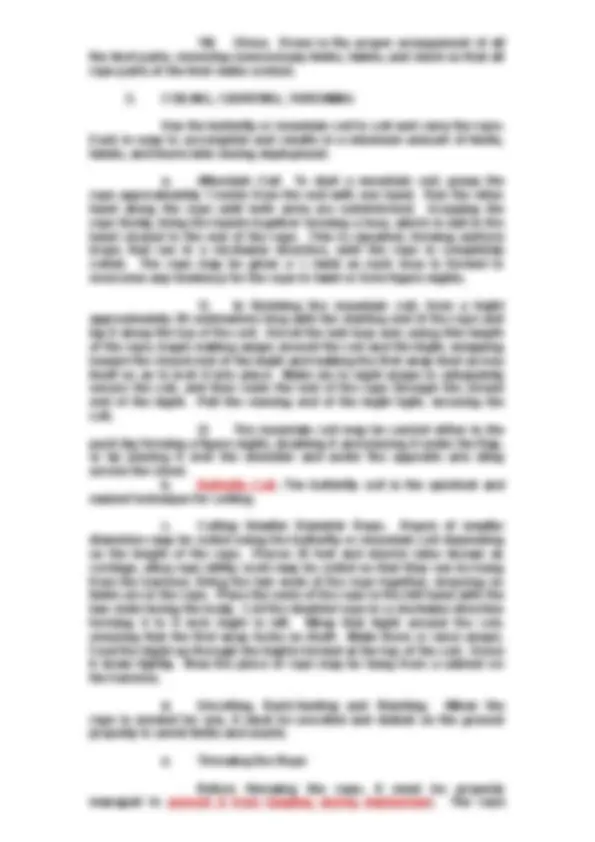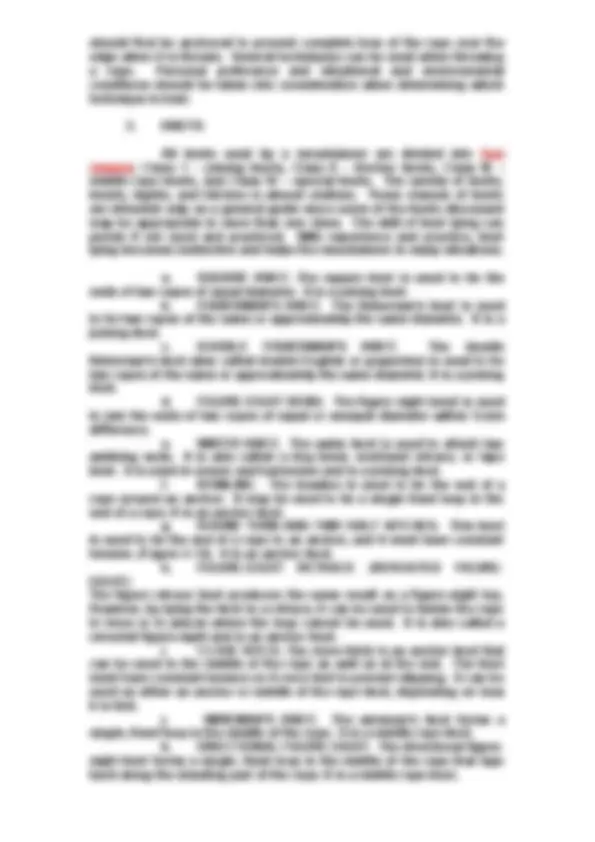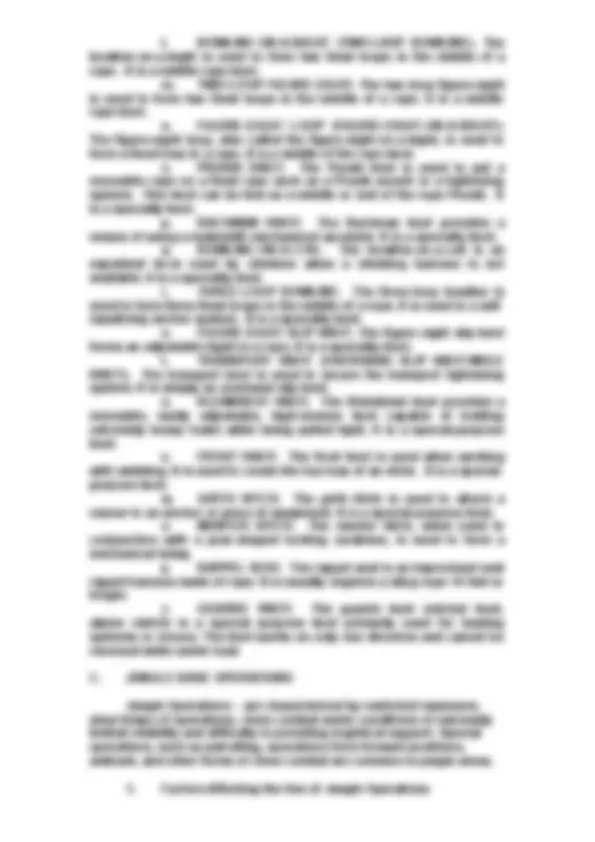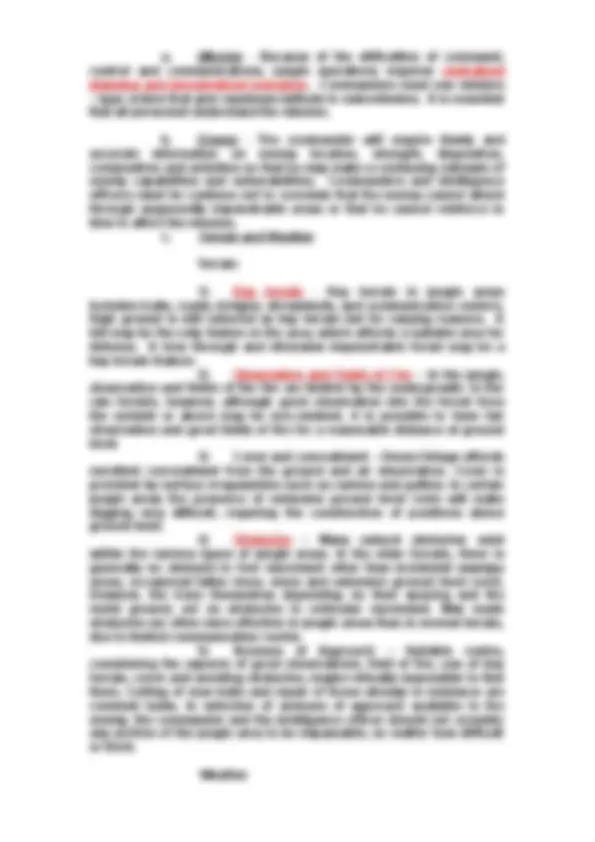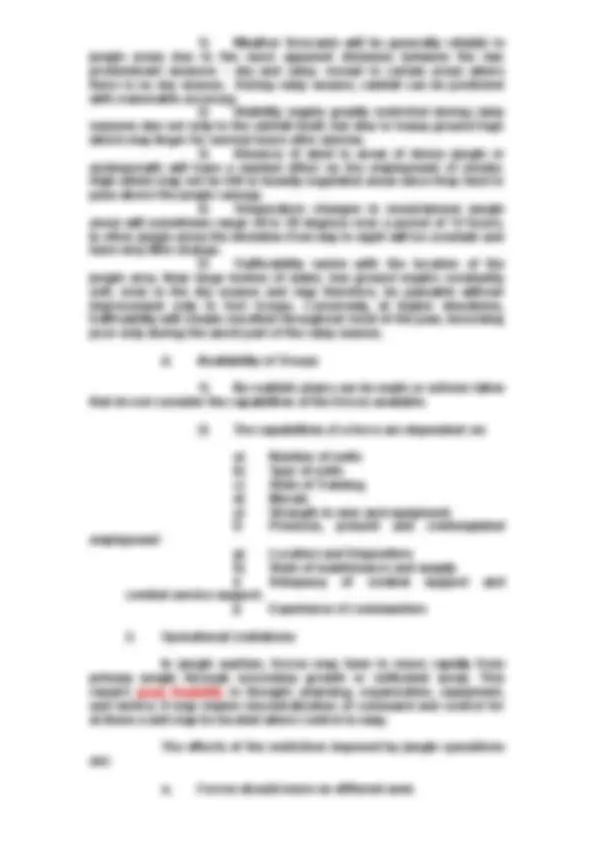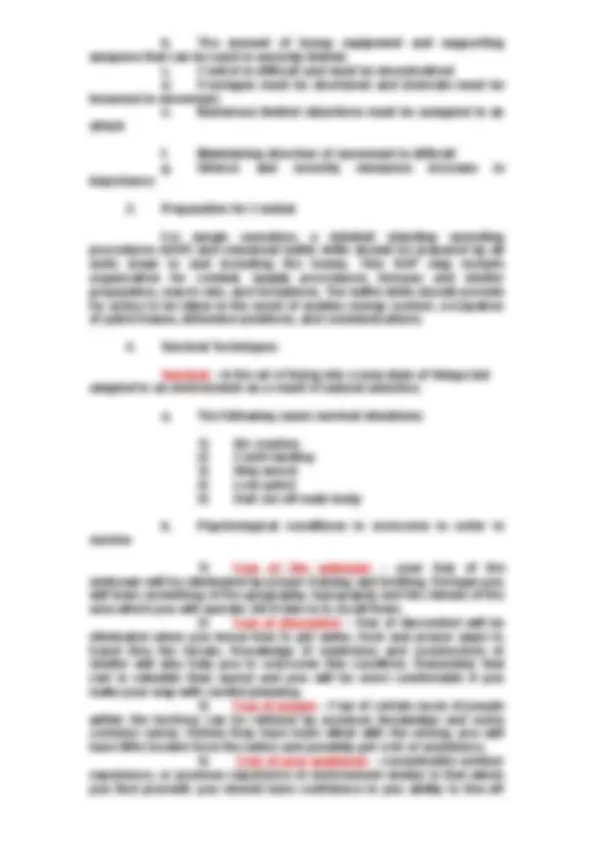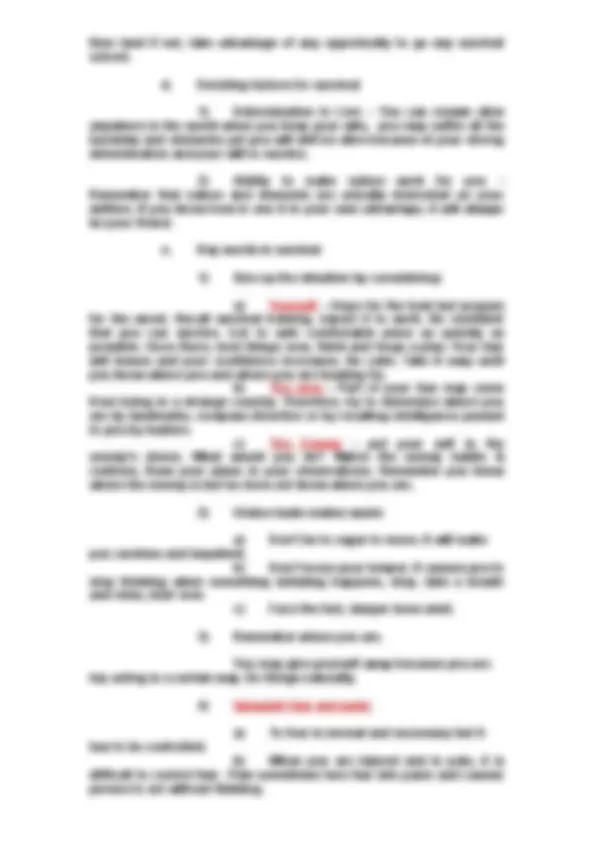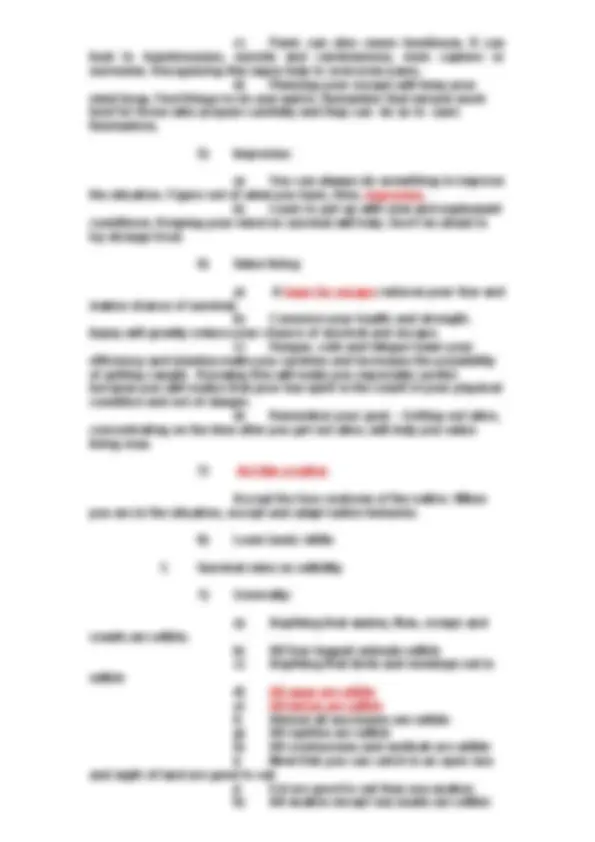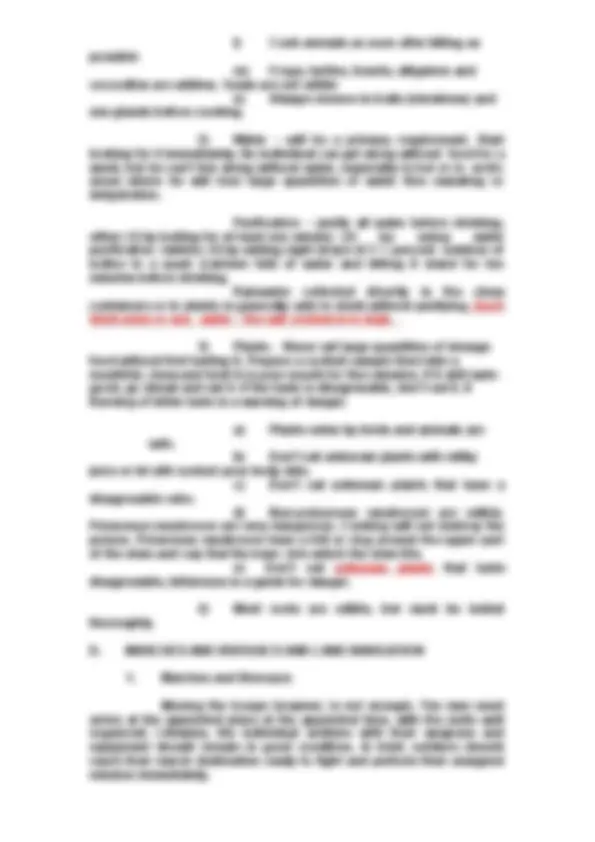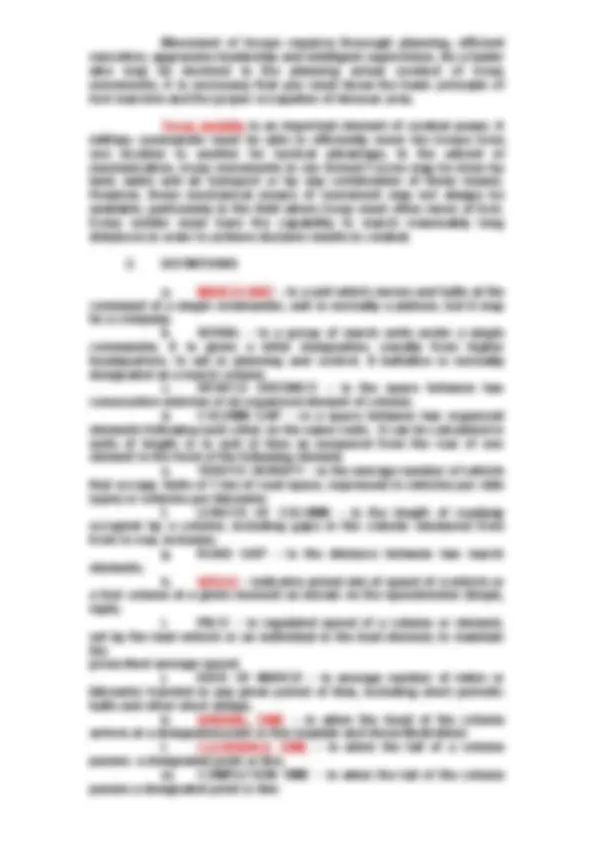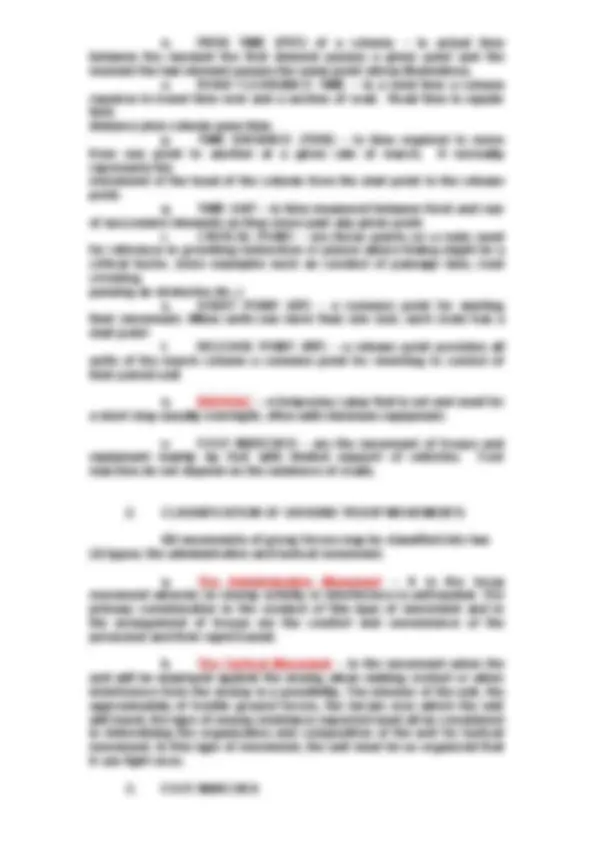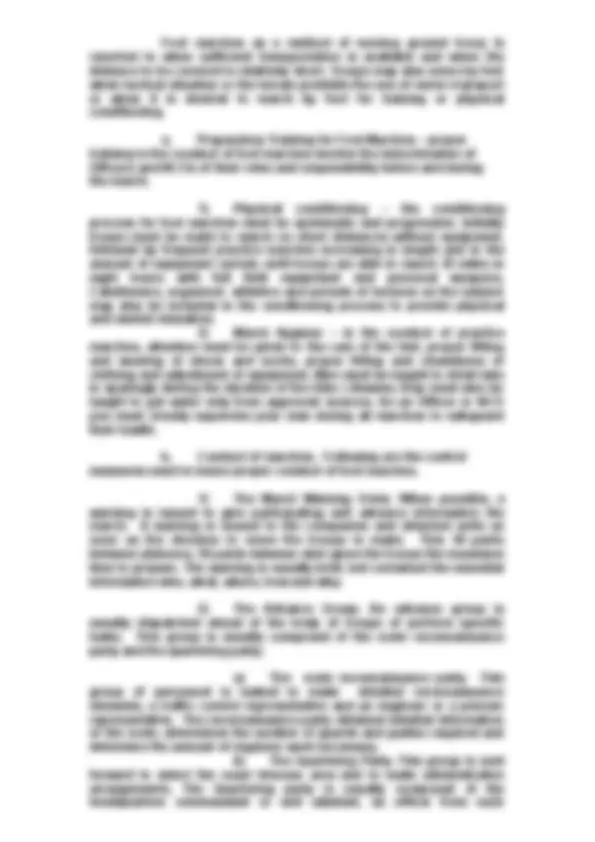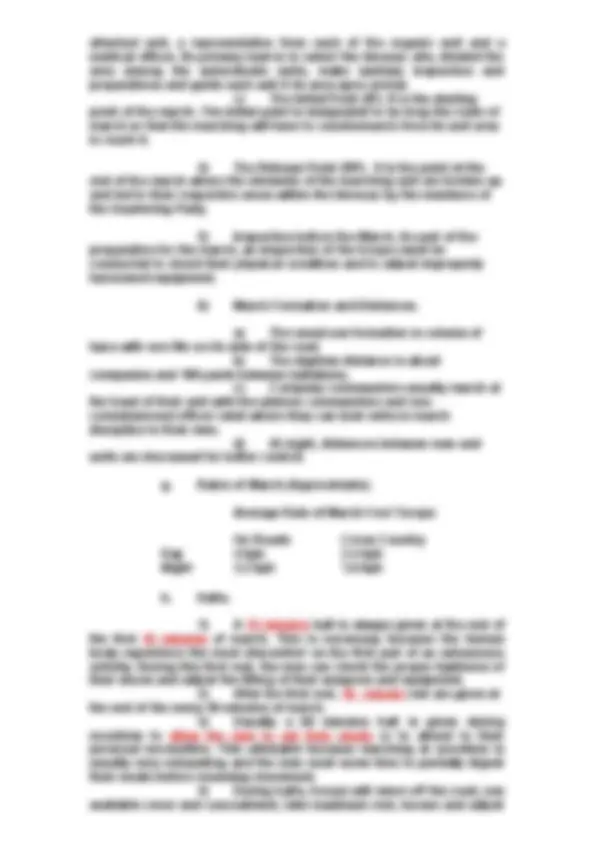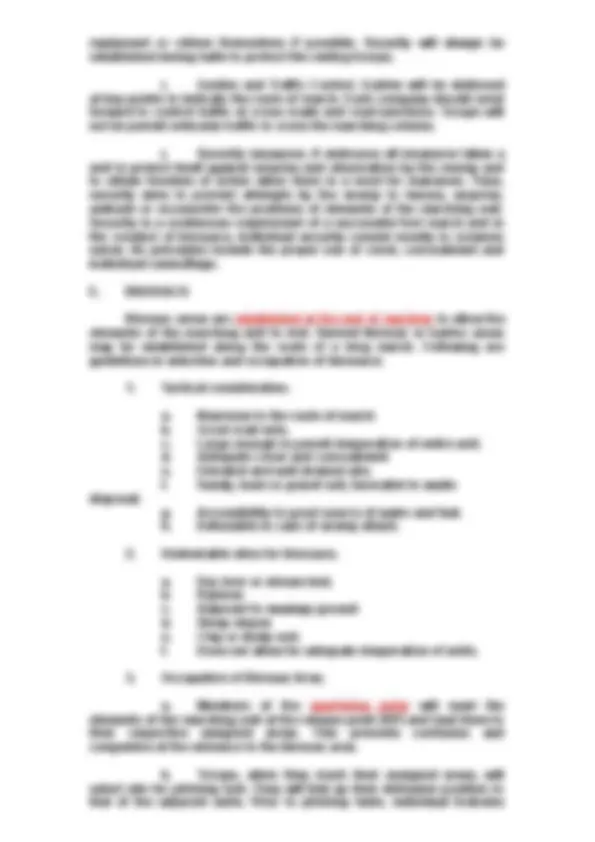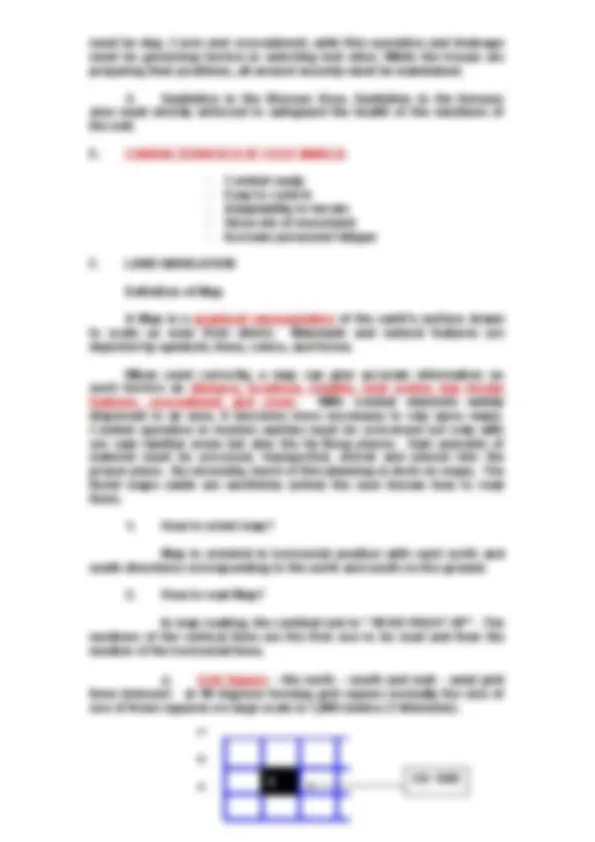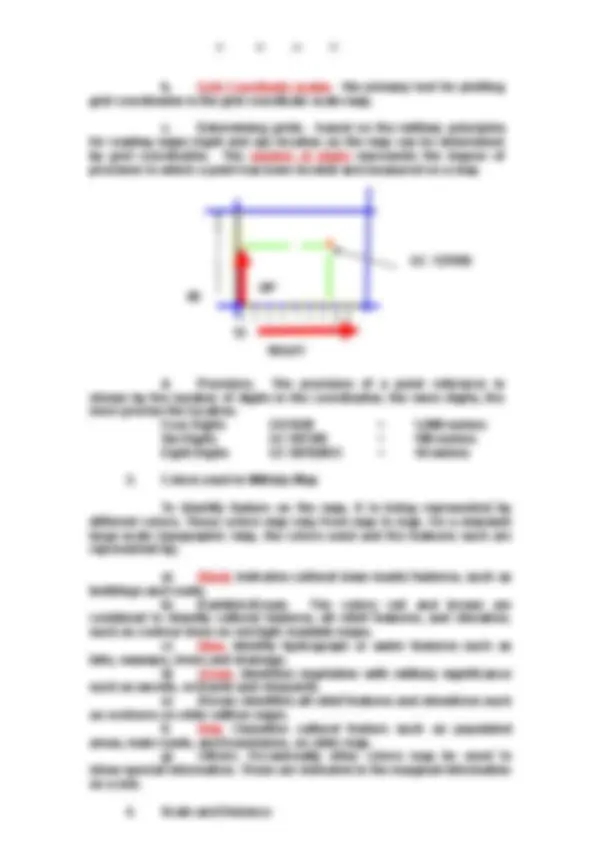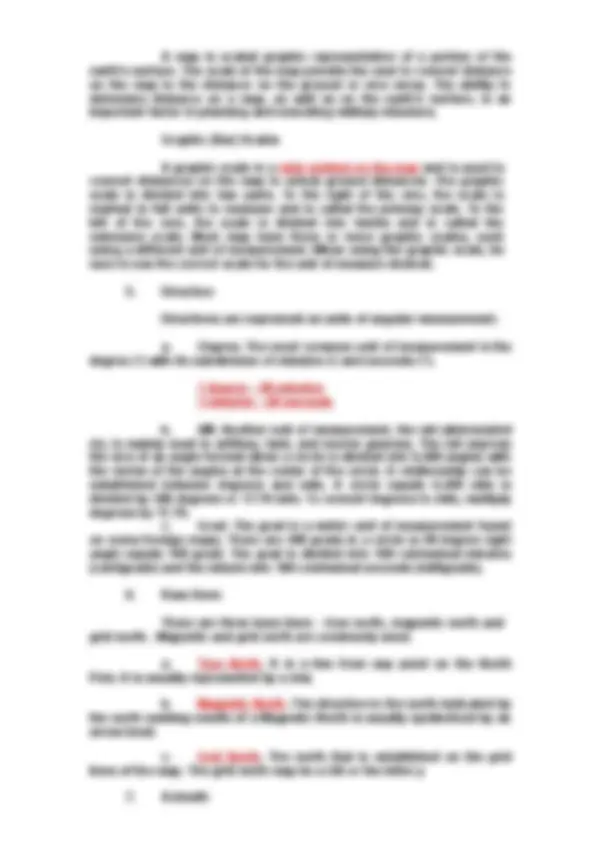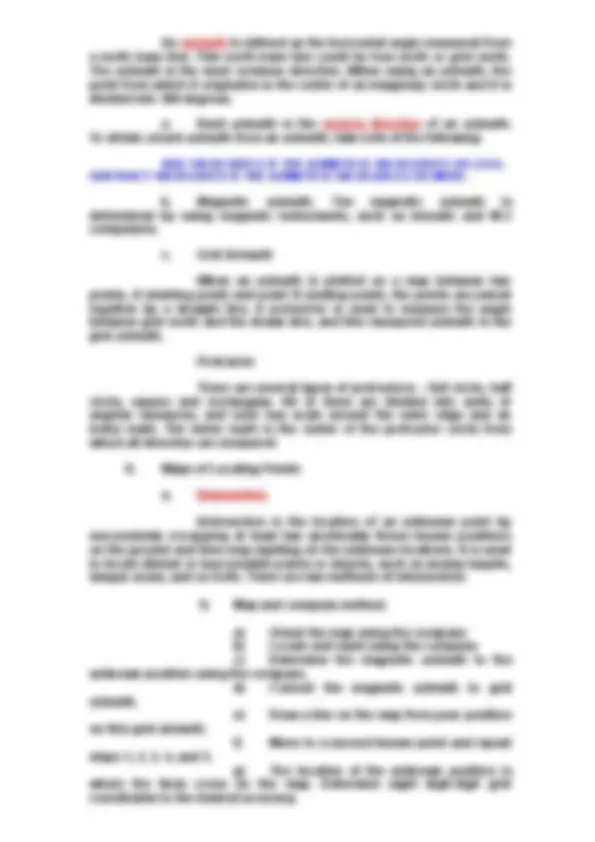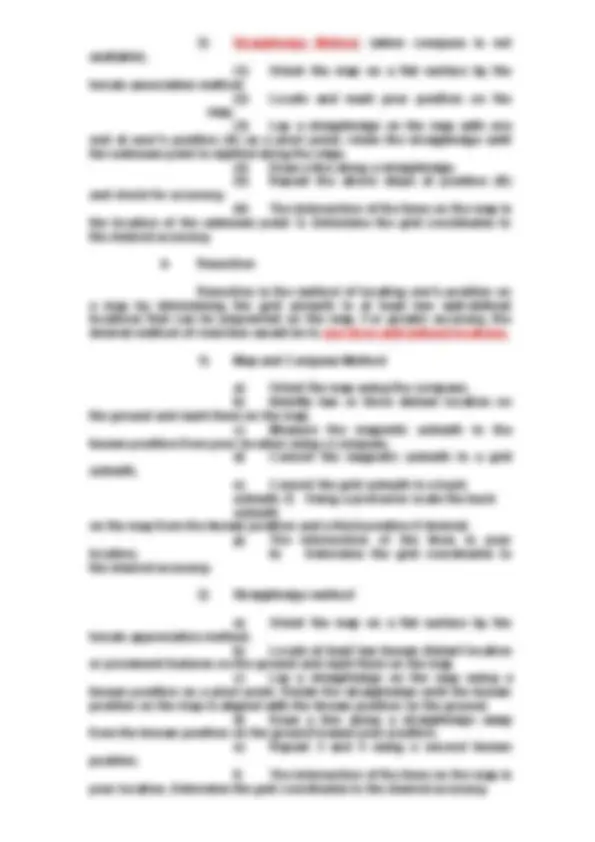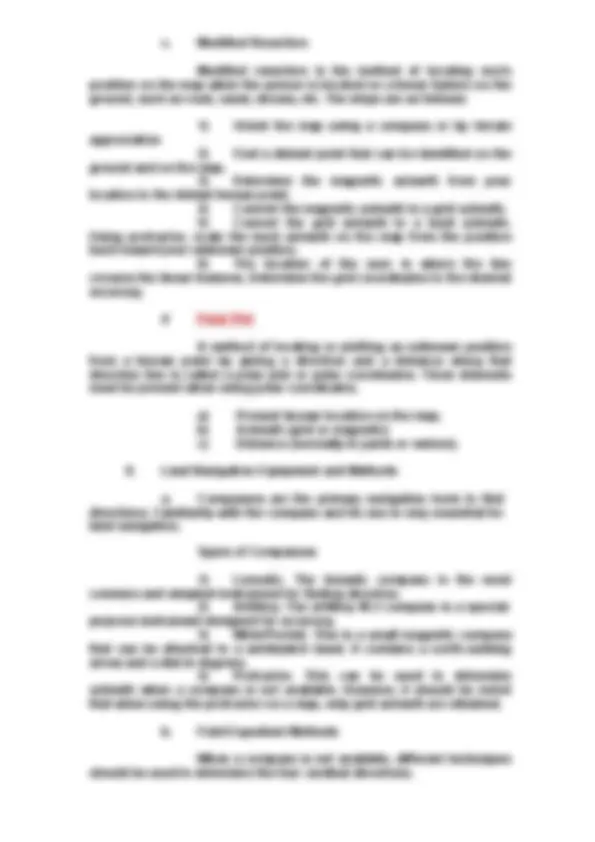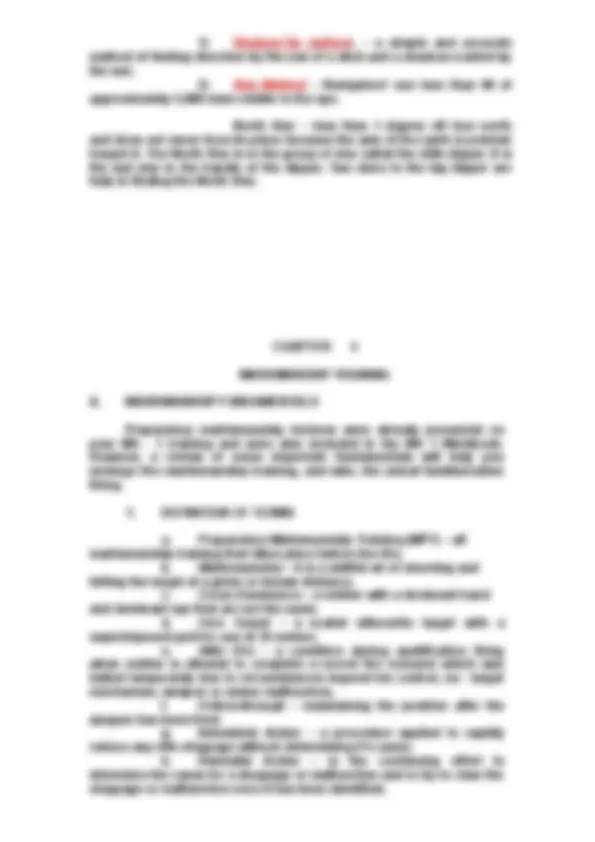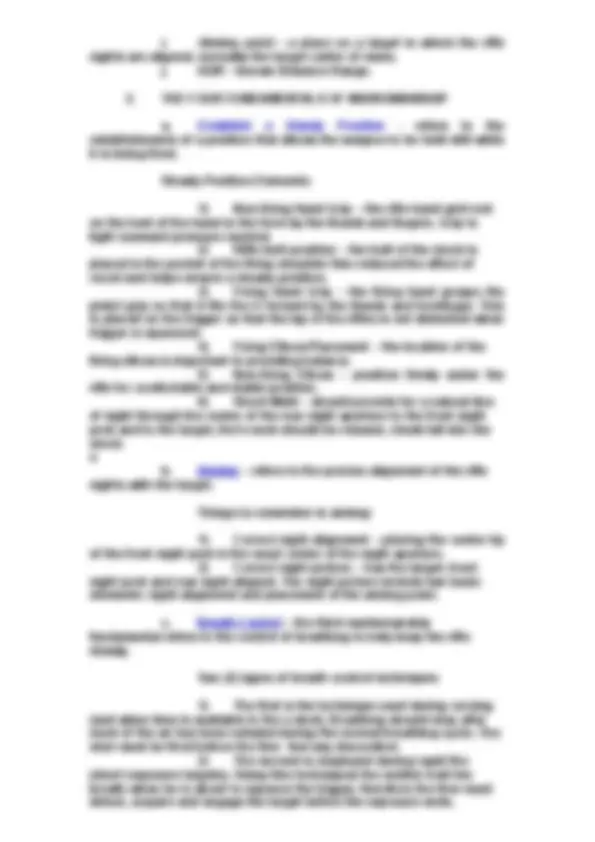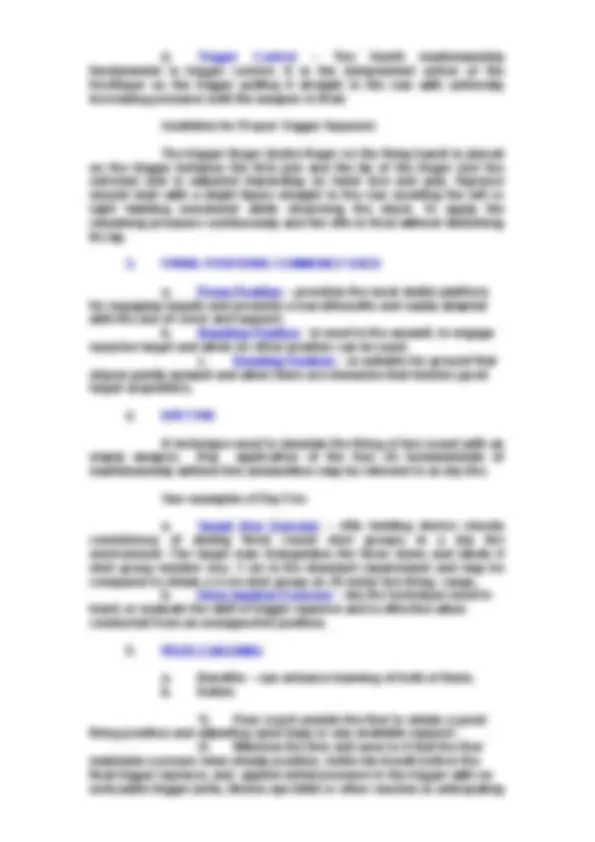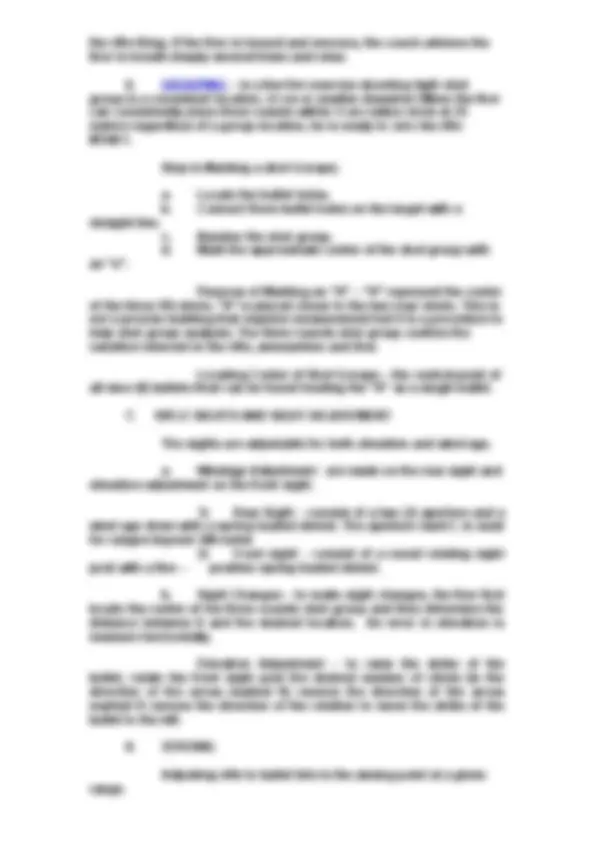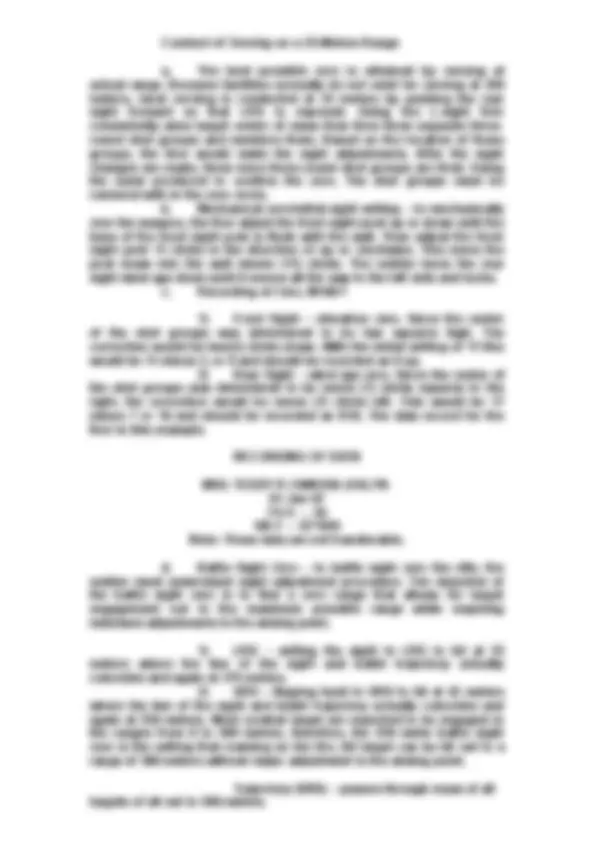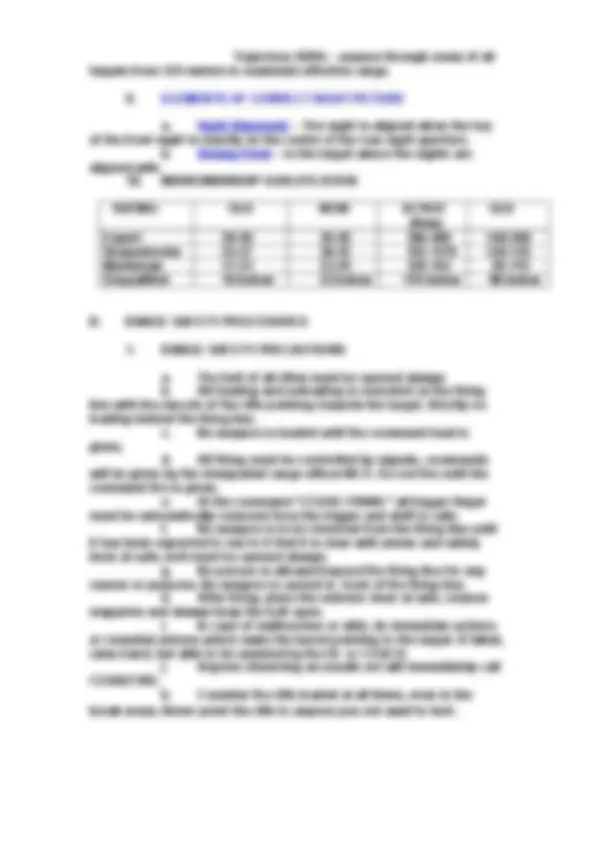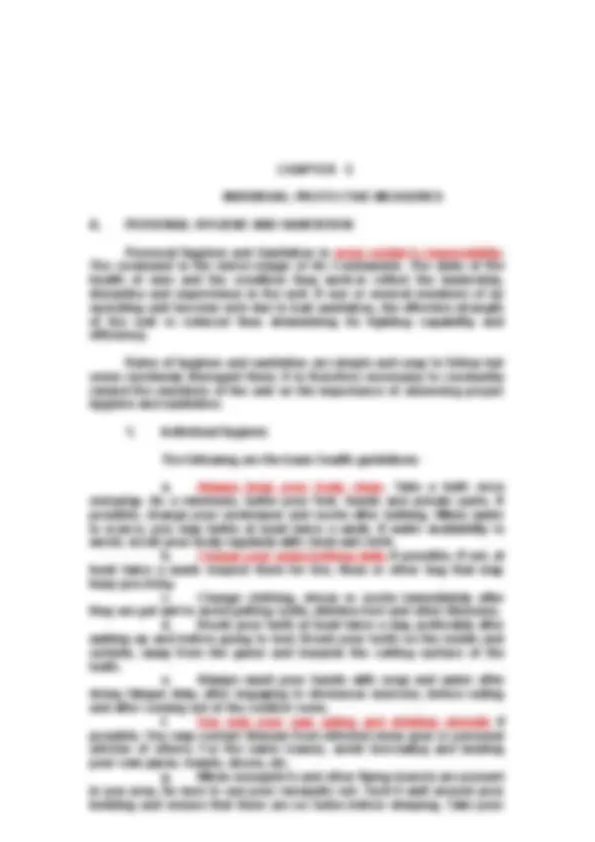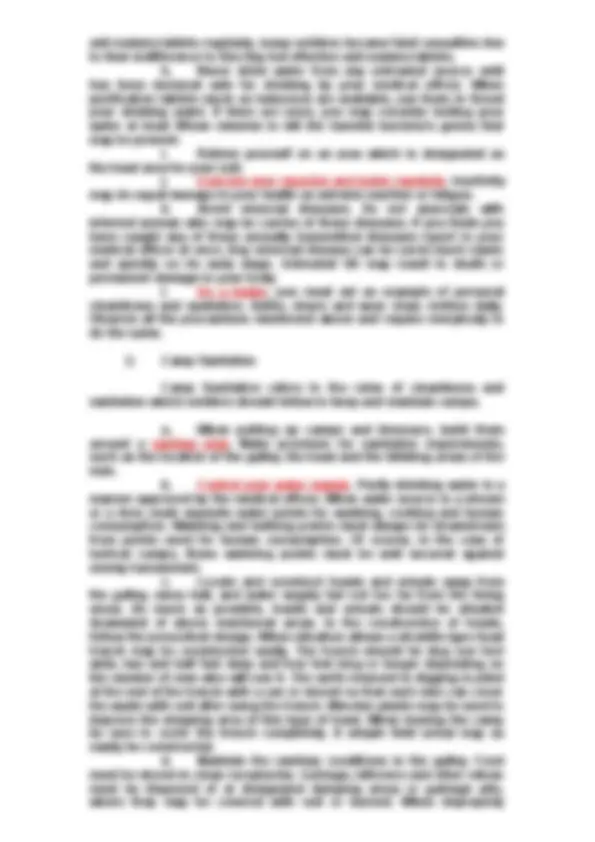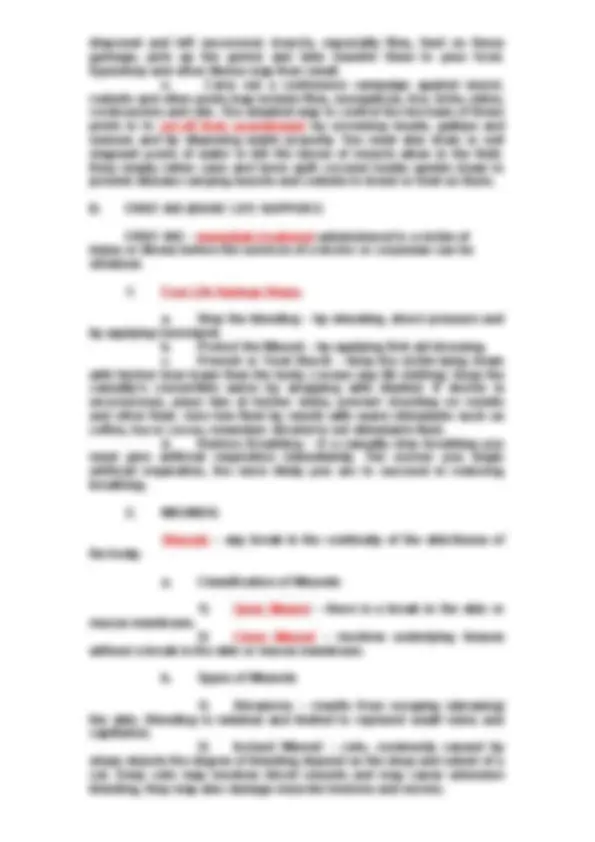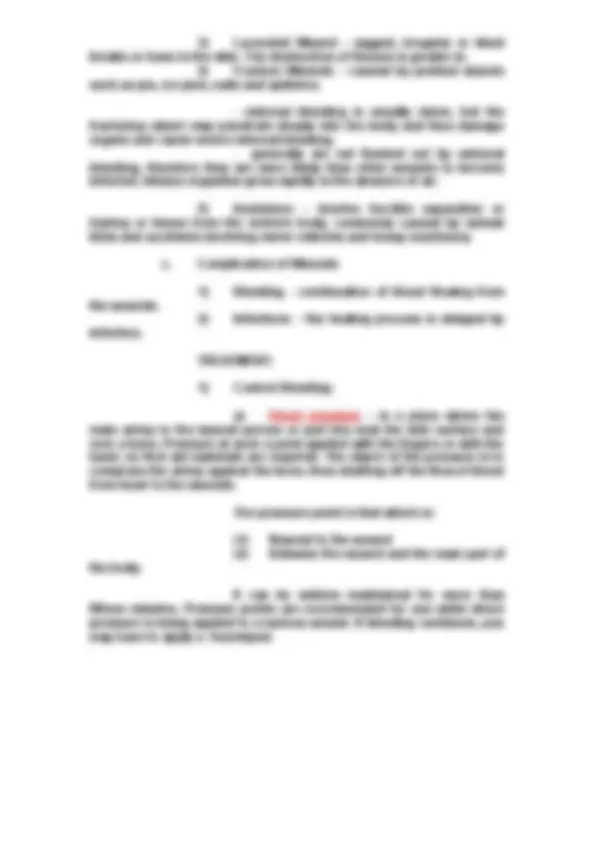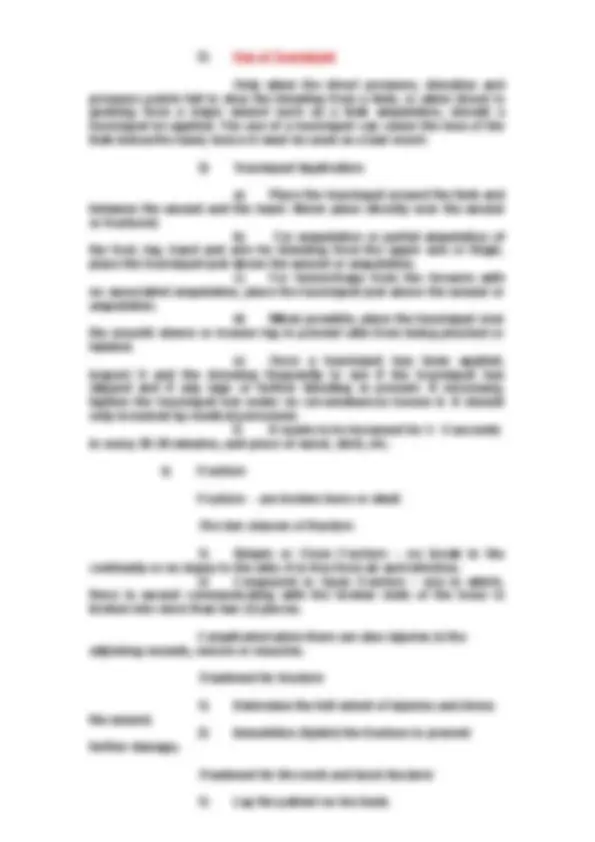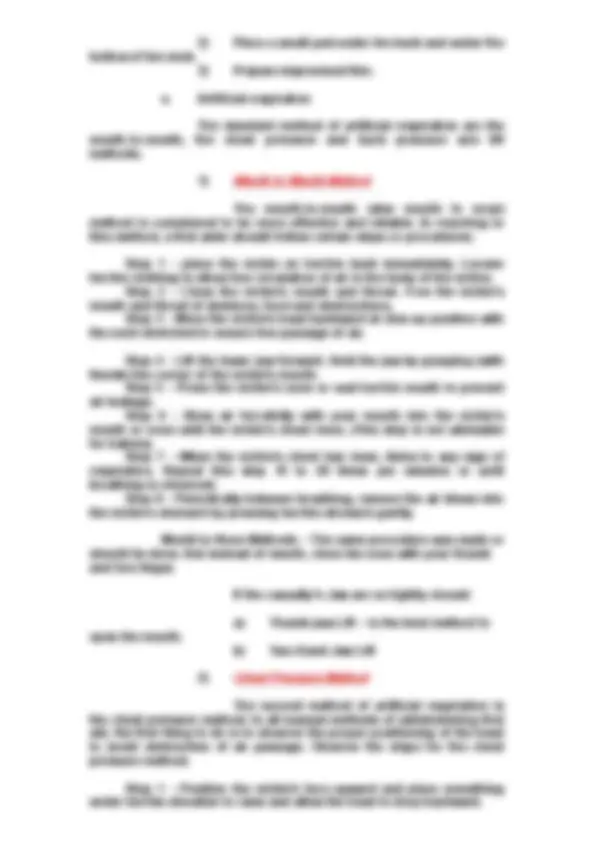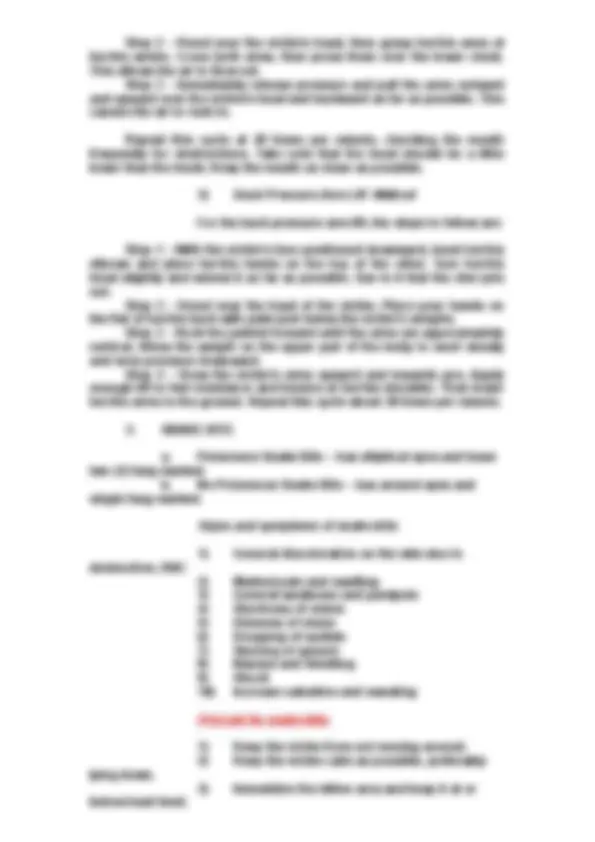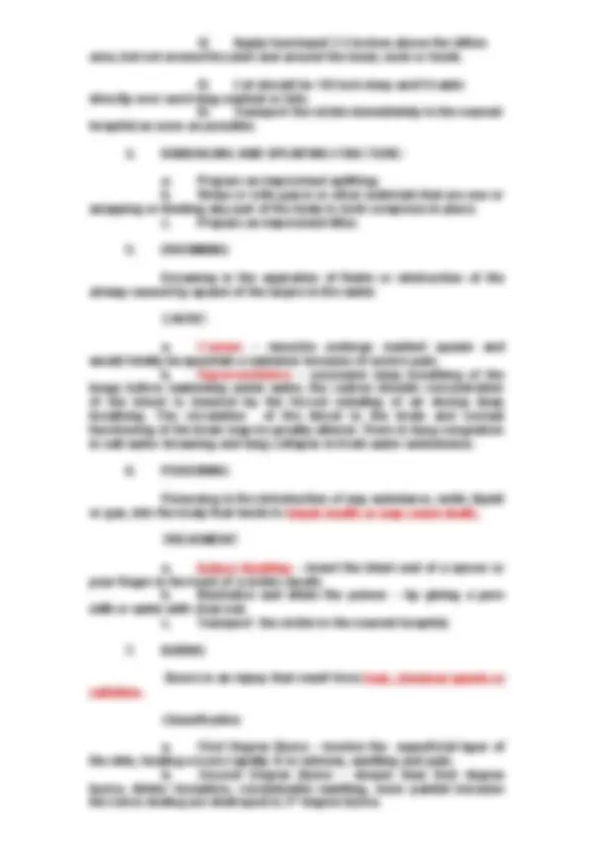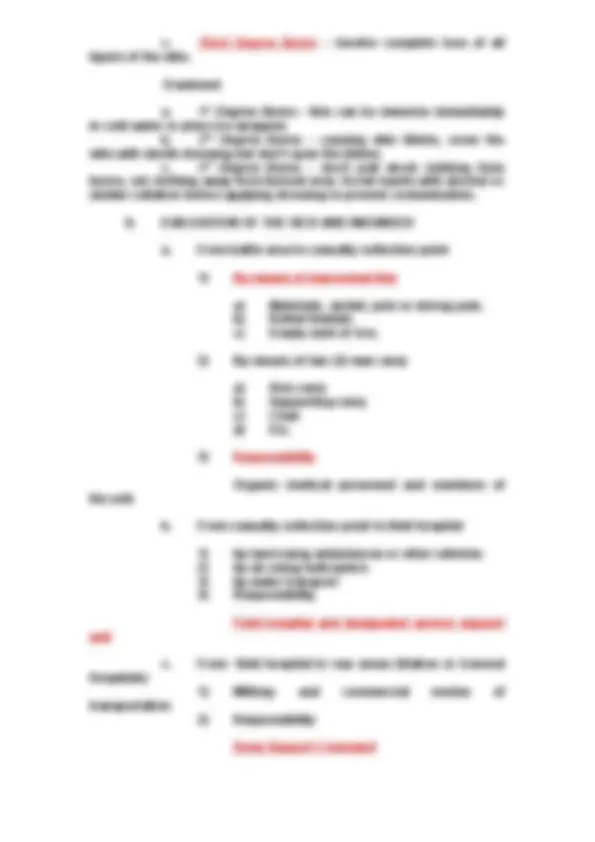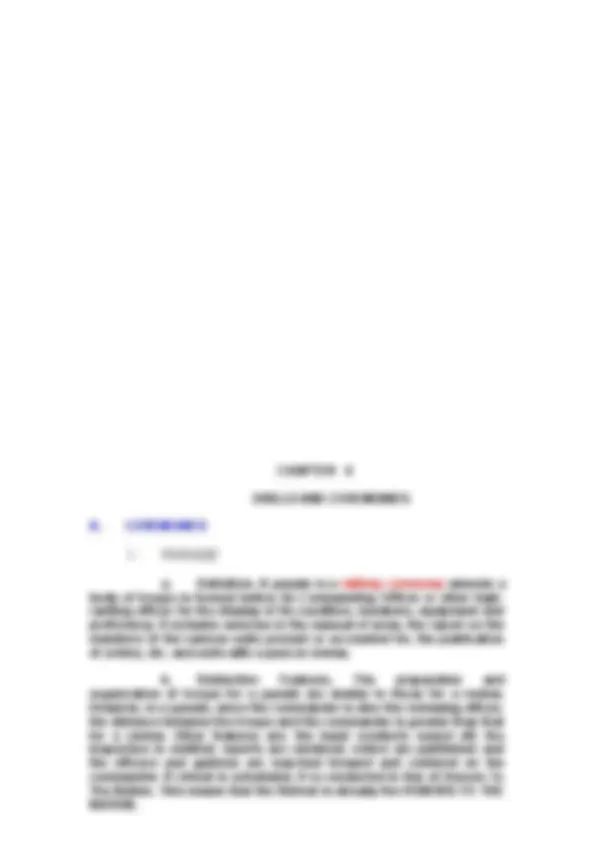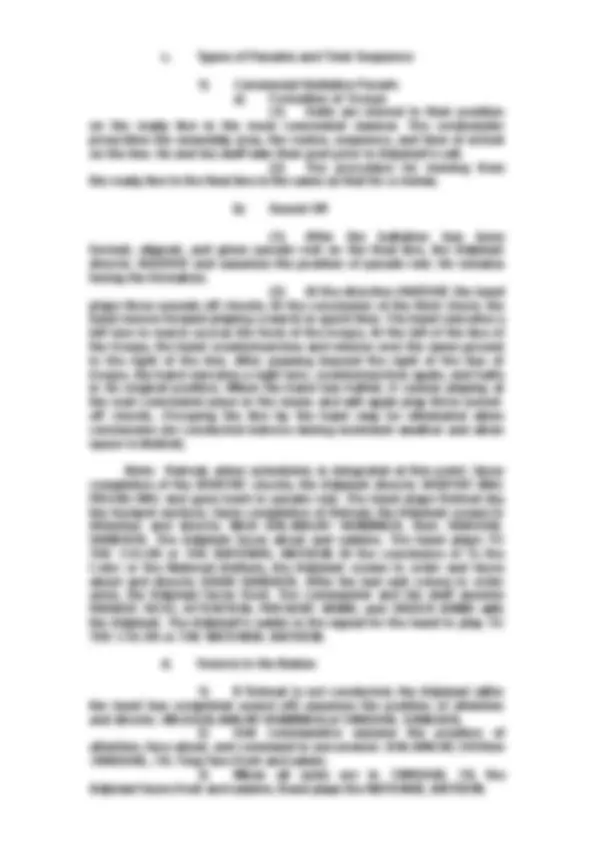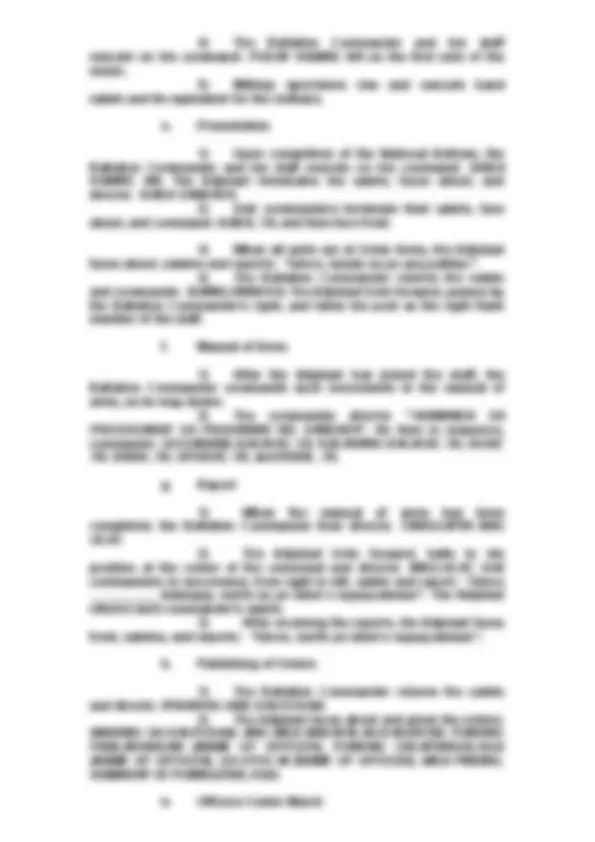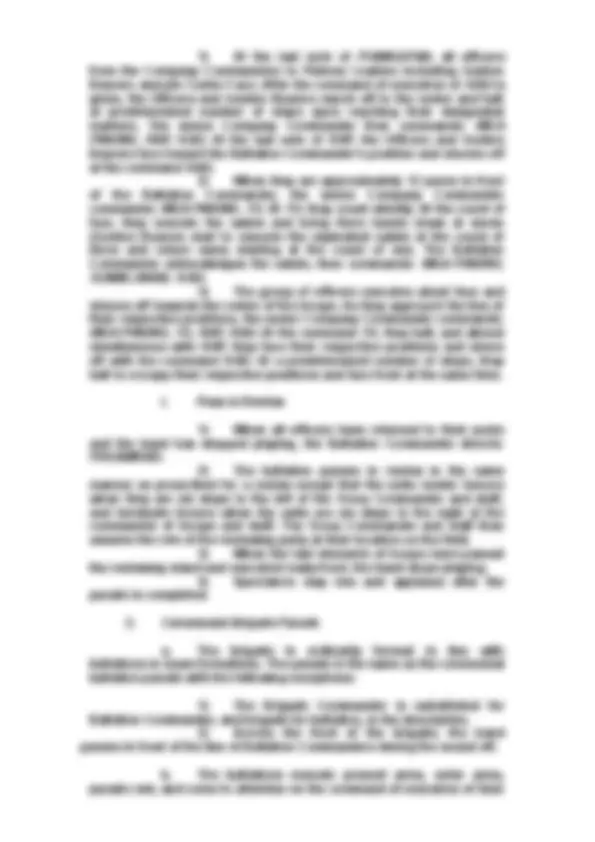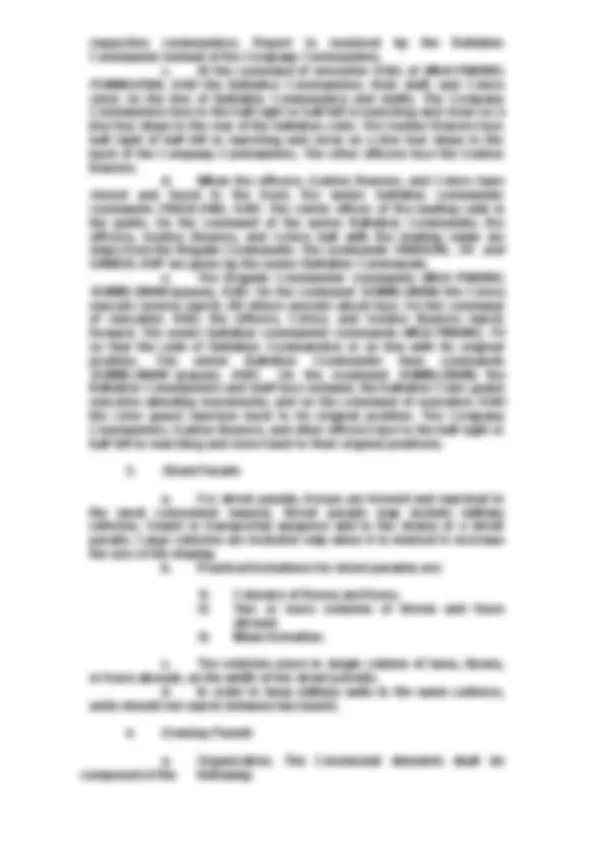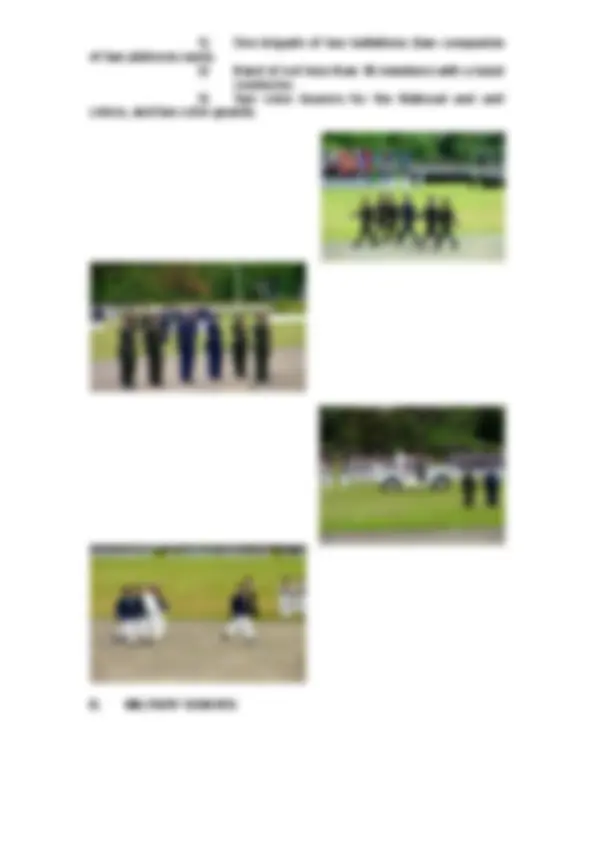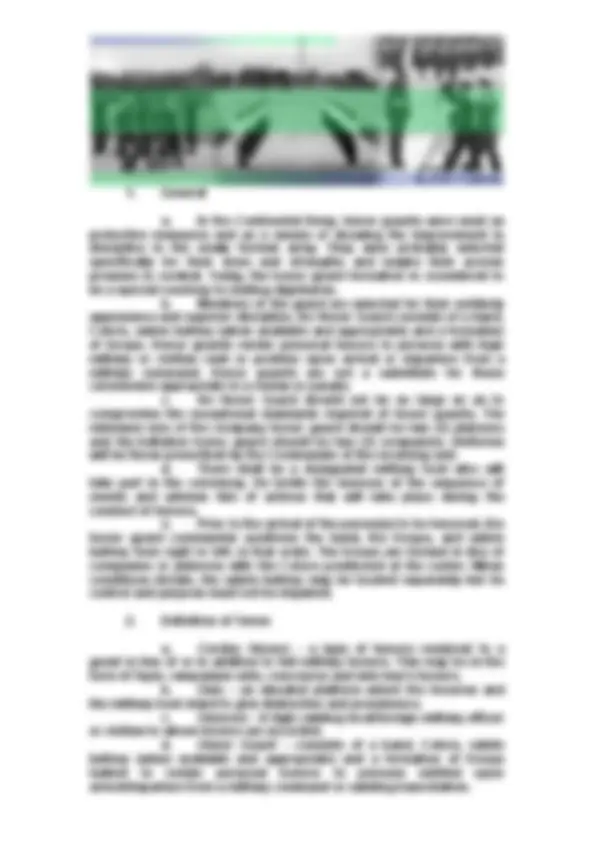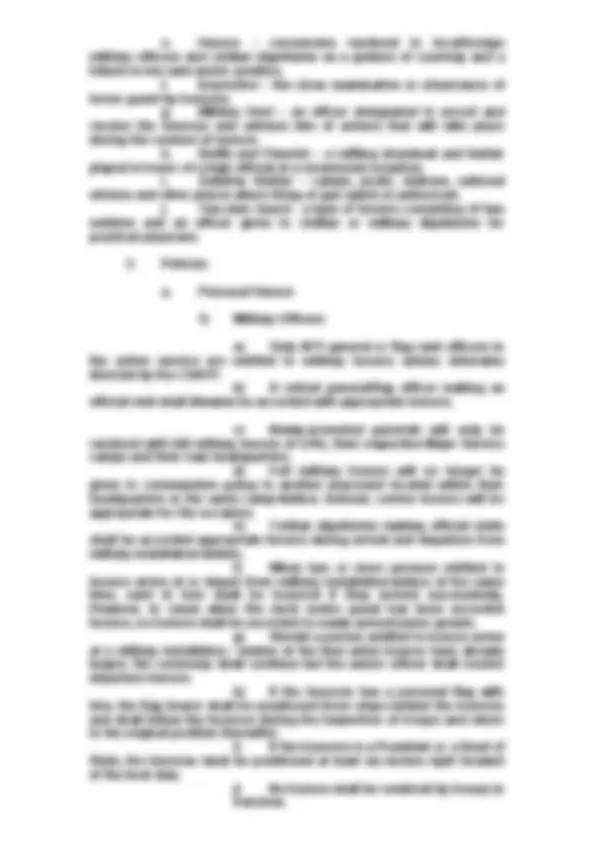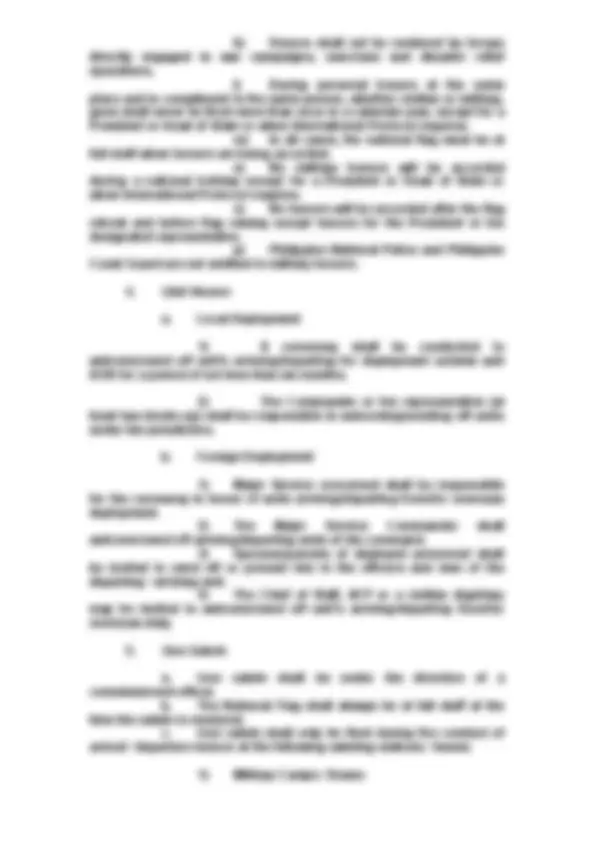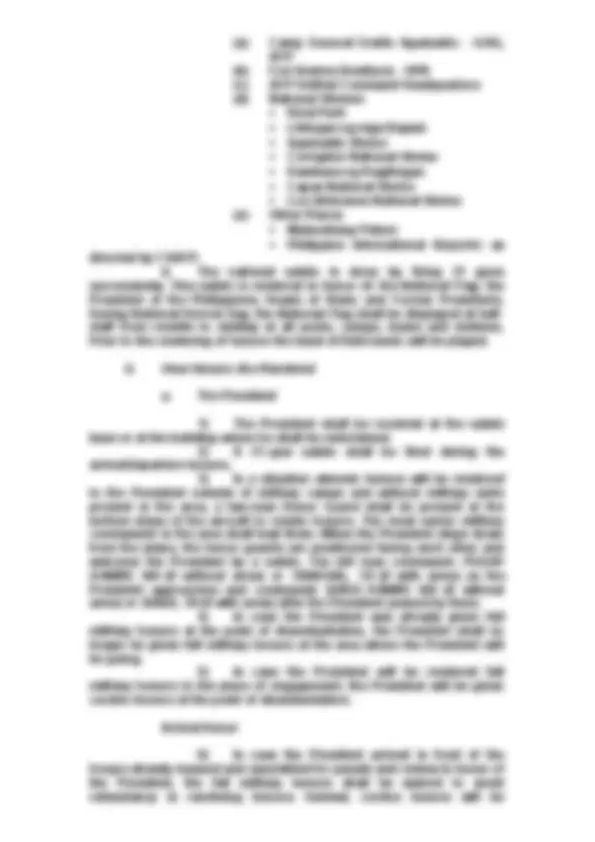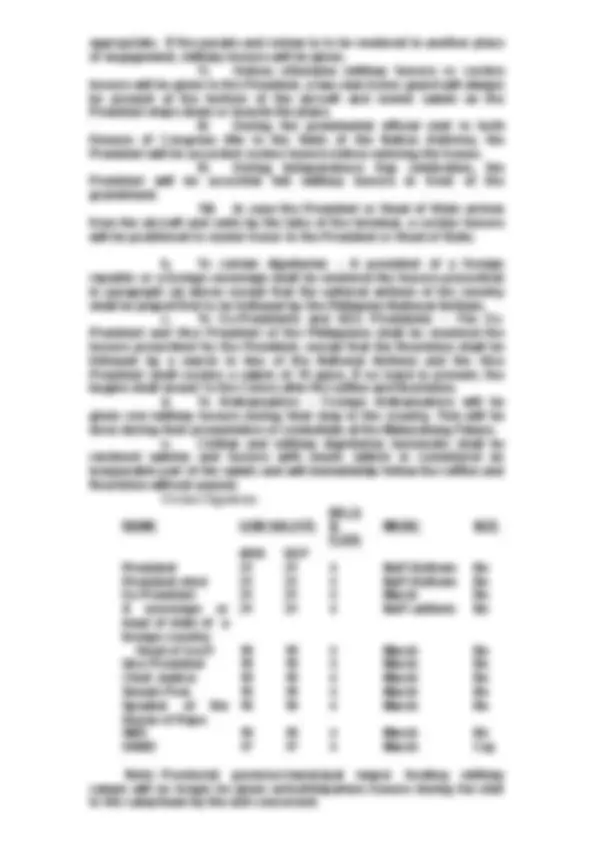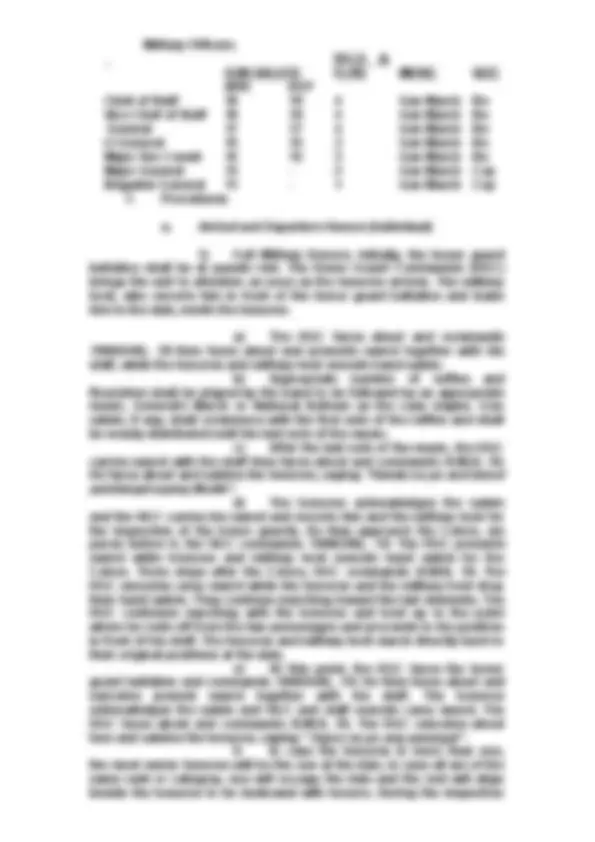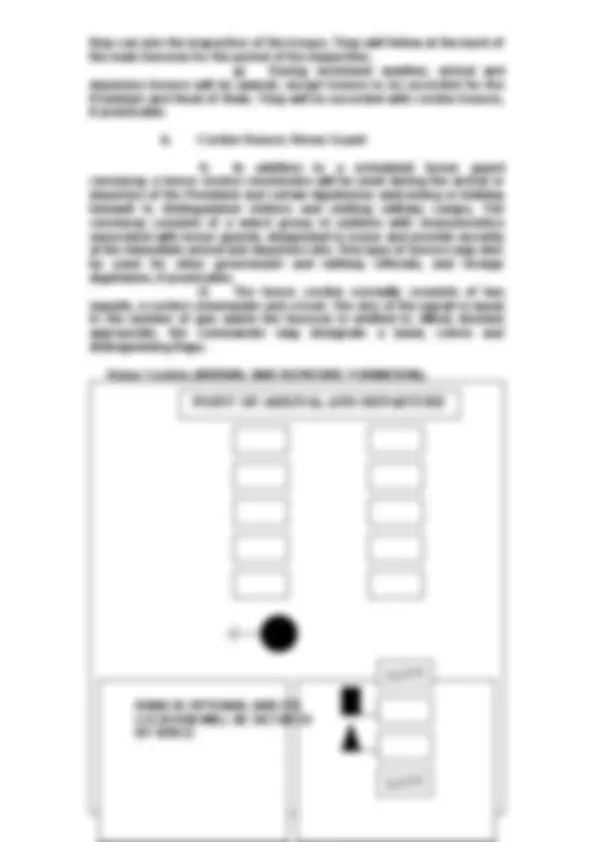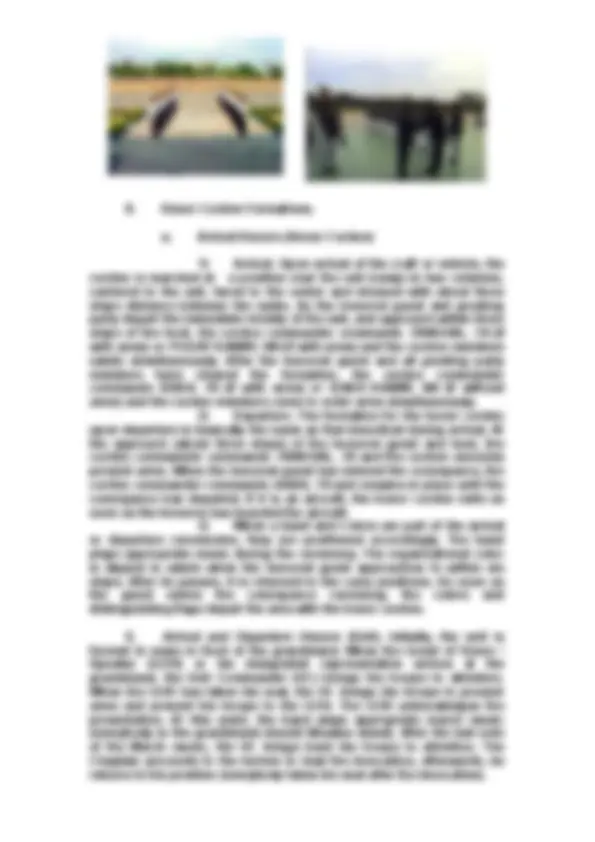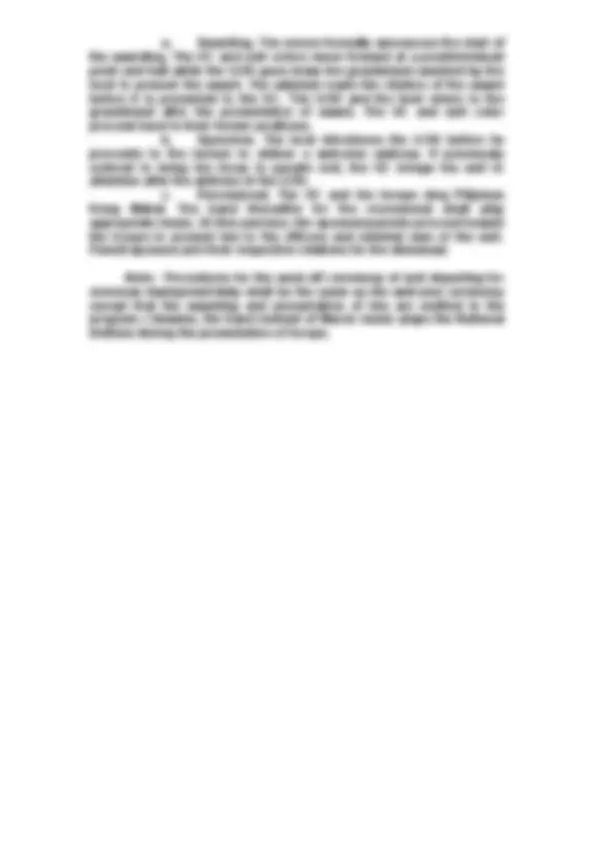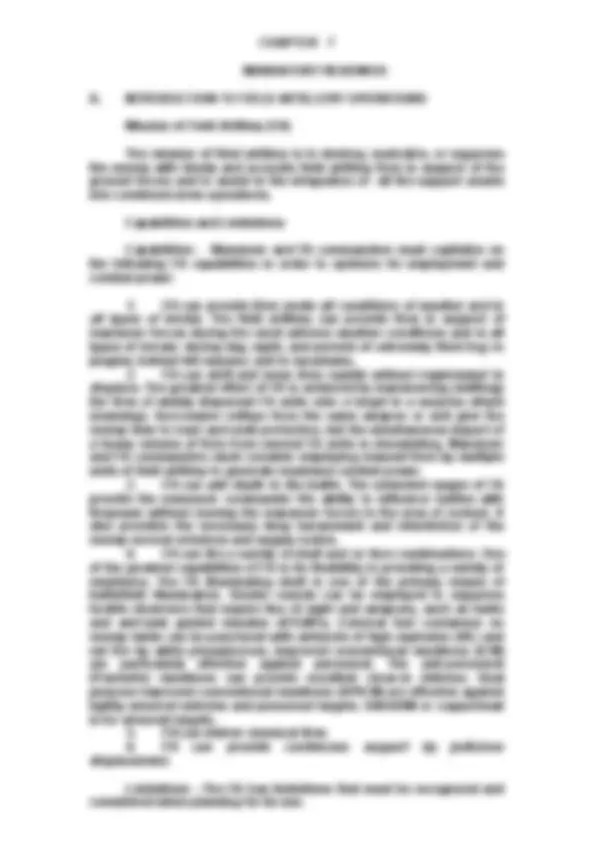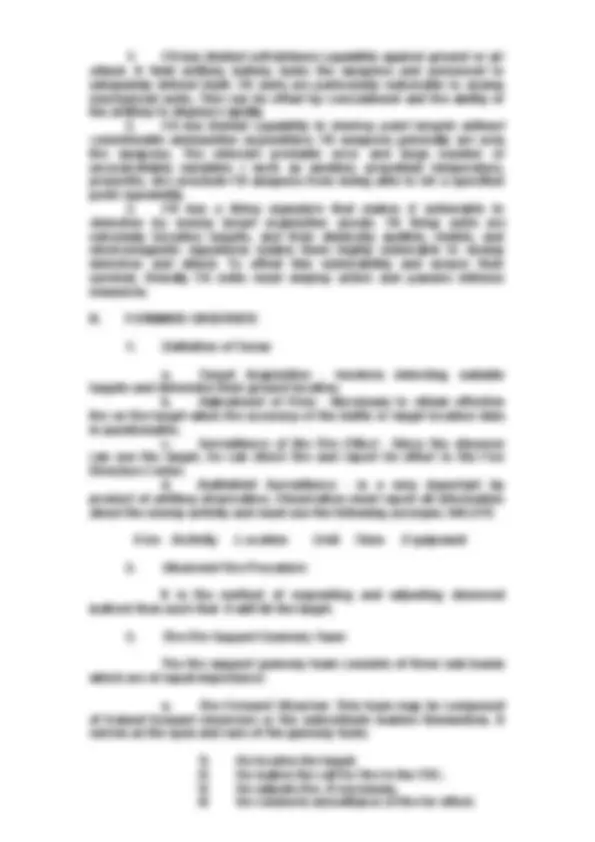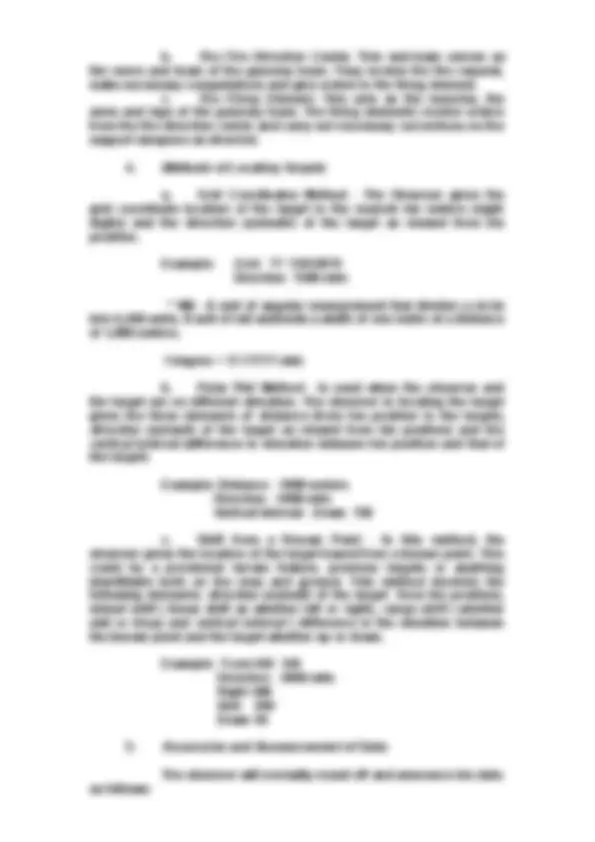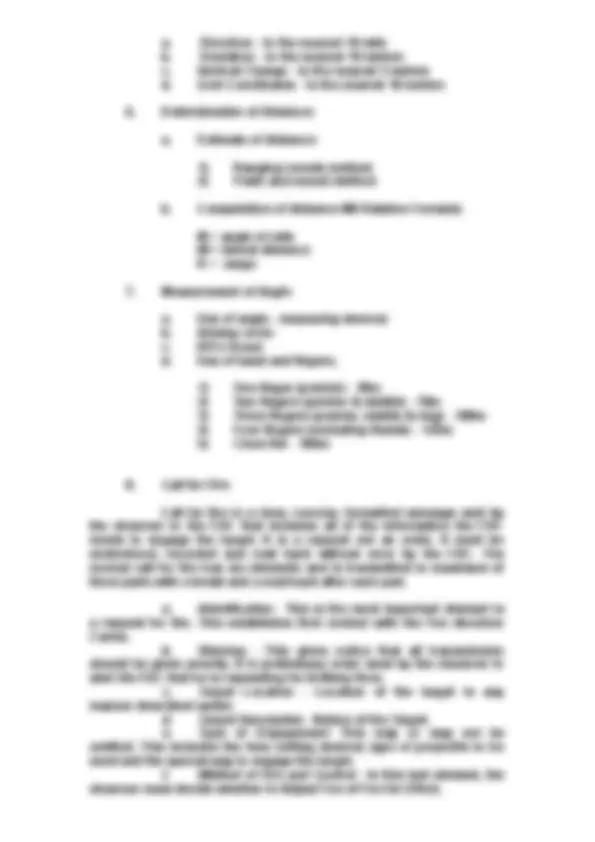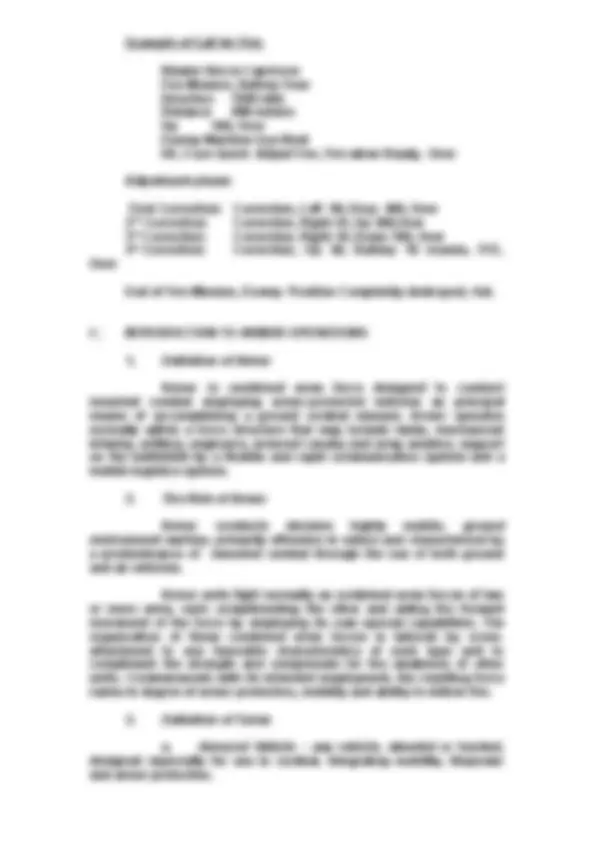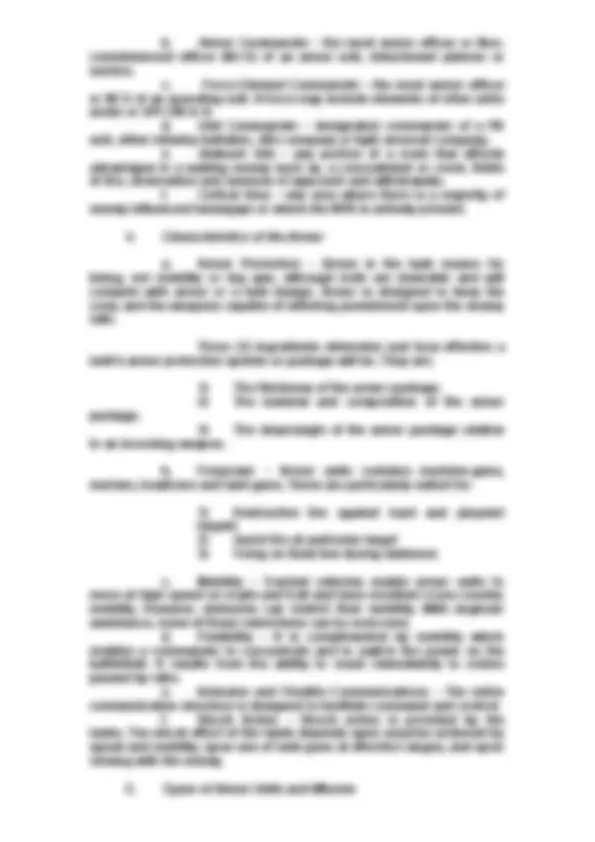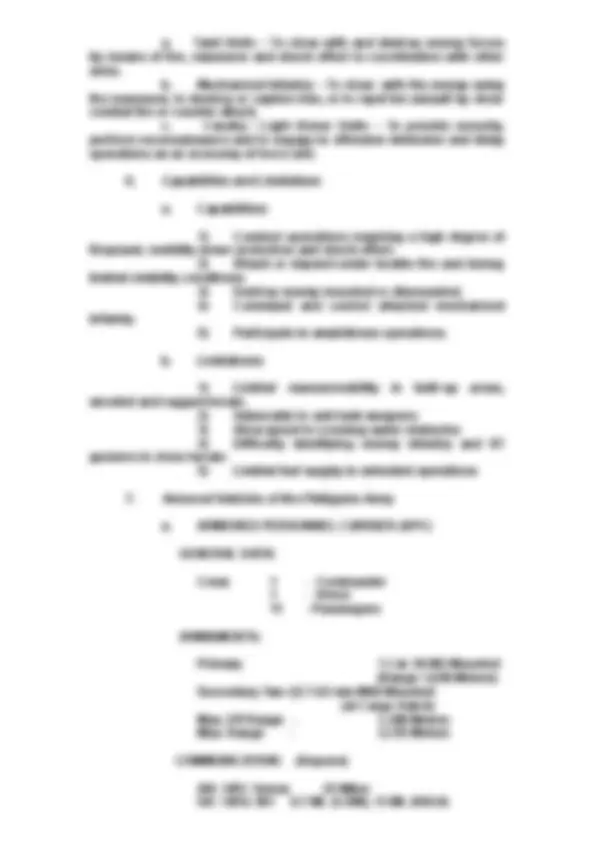Download Introduction to Military Operations and more Cheat Sheet Mechanical Engineering in PDF only on Docsity!
RESERVE OFFICERS TRAINING
CORPS
MILITARY SCIENCE - 2
WORKBOOK
(INSTRUCTOR’S COPY)
QUIRINO S CALONZO
SUBJECTS
(Military Science 2)
Chapters Pages
1. GENERAL MILITARY SUBJECTS
A. PA ORGANIZATION
B. TROOP LEADING PROCEDURE
C. RESERVIST AND RESERVE FORCE DEVELOPMENT
D. INTRODUCTION TO LOGISTICS
2. SMALL UNIT TACTICS
A. PATROLLING
B. RAIDS
C. AMBUSCADES
D. RIFLE SQUAD TACTICS
3. INDIVIDUAL/UNIT TRAINING
A. VISUAL TRACKING
B. MILITARY MOUNTAINEERING
C. JUNGLE BASE OPERATION
D. MARCHES AND BIVOUACS AND LAND NAVIGATION
E. MAP READING
F. MILITARY STAKES
4. MARKMANSHIP TRAINING
A. MARKMANSHIP FUNDAMENTALS
B. RANGE SAFETY PROCEDURES
5. INDIVIDUAL PROTECTIVE MEASURES
A. PERSONAL HYGIENE AND SANITATION
B. FIRST AID (BASIC LIFE SUPPORT)
6. DRILLS AND CEREMONIES
A. DISMOUNTED DRILLS
CEREMONIES
7. MANDATORY READINGS
A. INTRO TO ARTILLERY OPERATIONS
B. FORWARD OBSERVER
C. INTRODUCTION TO ARMOR OPERATIONS
D. INTRODUCTION TO UNCONVENTIONAL WARFARE
E. PLATOON TACTICS
F. CREW SERVE WEAPONS’ TRAINING
1) 60MM/81MM MORTAR
2) CAL .50 MACHINE GUN
CHAPTER 1
GENERAL MILITARY SUBJECTS
A. PHILIPPINE ARMY ORGANIZATION
MISSION: To provide command, control and supervision of element (organic and attach) in support of its security role by planning, directing and reviewing the operation and administration of the Army establishment, regular and reserve, to include the organization, training, equipment and development of land forces on the conduct of prompt and sustained combat operations on land in accordance with plans for national security and to perform such peacetime task as may be directed. FUNCTIONS:
- Provide staff planning, control and supervision of administration and operation of the Philippine Army.
- Plan for and provide direction and supervision related to civil function such as: a. Participation in Socio –Economic Military Program b. Emergency function in the public interest, such as disaster relief and domestic disturbance, the latter when directed by higher authority. c. Operation of essential utilities directed towards national interest. d. Civil Works, such as flood control.
- Prepare plans and program for use of Army, both separately and in conjunction with air and naval forces in organizing, supplying, equipping, training, mobilizing and demobilizing the Philippine Army.
- Prepare detailed instruction for the execution of approved plans and to supervise the execution of such plan.
- Supervise the development, execution and review and analysis of Army Programs, to include budgetary and logistical considerations. SERVICE SUPPORT UNITS COMBAT SUPPORT UNITS COMBAT ARMY ENGR BDE INF DIV SOCOM LA Bde 525 ECB 1 S G SIG BN CAG PRESENT PA ORGPANIZATION UNIT RESCOM TRADOC ASCOM AMIC FIN CTR HHSG SEG
- Individuals of this unit, except those specifically exempted by existing regulations and laws, can fight as infantrymen when required. COMBAT UNITS
- INFANTRY DIVISION MISSION: To destroy enemy military forces and to control land areas including population and resources. FUNCTIONS: a. Conduct independent offensive and defensive operations. b. Conduct sustained combat operations against similarly or less equipped land forces independently or as part of a larger force. c. Conduct operations in any local weather and terrain and in any visibility condition. d. Participate in air assault operations. e. Participate in amphibious operations. f. Control population and restore order. g. Operate in conjunction with heavy forces. h. Rapidly accept and integrate augmenting forces.
- LIGHT ARMOR DIVISION MISSION: To destroy enemy military forces and to control land areas including population and resources. FUNCTIONS: a. Conduct sustained combat operation against similarly or lass well-equipped land forces independently or as part of a larger forces. b. Conduct independent offensive, defensive and retrograde operations. c. Conduct operations in any local weather and terrain and in any visibility condition. d. Disperse over great distances and concentrate rapidly from widely separated areas. e. Act as covering forces in offensive, defensive and retrograde operations. f. Participate in amphibious operations. g. Operate in conjunction with light forces. h. Rapidly accept and integrate augmentation forces.
- SPECIAL OPERATION COMMAND, PHILIPPINE ARMY MISSION: To plan for, conduct and support special operations. FUNCTIONS: a. Conduct unconventional warfare operations.
j. Act as commodity manager on Commel supplies and equipment for acquisition.
- CIVIL AFFAIRS GROUP, PHILIPPINE ARMY MISSION: To conduct Psychological Operations in support to Army units and to conduct Civil Affairs activities in coordination with the Local Government agencies (LGU’s), Local Government Units (LGU’s), Non Government Organization (NGO’s), People Organization (PO) and other sectors of society aimed at winning the heart and mind of the people. FUNCTIONS: a. To influence the people’s emotion, belief, behavior and attitude as well as the enemies in favor of the AFP and the government. b. To weaken the will of the enemy to fight to reduce their strength by inducing surrender, defection and desertion. c. To conduct research and area studies to determine the issues obtaining in the target areas for propaganda exploitation. d. To conduct counter-PSYOPS to negate enemy propaganda. e. To establish a good working relationship with the media, LGA’s, LGU’s, NGO’s, PO’s and other sector to have a concerted efforts in uplifting the plight of the people in the depressed areas. f. To conduct civil affairs activity in coordination with other AFP units NGO,s and LGU’s. g. To plan, provide, conduct and evaluate PSYOPS actions covering the following areas of concerns security and laws enforcement, religious, economic, social, political, educational, cultural, heath and media people. h. To analyze and evaluates propaganda activities and conduct counter PSYOPS. i. To conduct and provide instructions for CMO, PSYOPS, Tri Media, Public Affairs Courses and SOT training. j. To develop produce, and evaluate PSYOPS products using the following forms of media, face to face , radio, TV and object merchandize. k. To maintain networking with LGU’s, LGA’s, and NGO’s for a collaborated effort in the conduct of humanitarian assistance in depressed localities tagged as national priority areas. l. To enhance the socio-economic well-being of soldiers and their dependence through livelihood training. m. To conduct news coverage of all command activities. n. To provide command and control of PA NCR DRTU. o. To conduct photo/video coverage, film showing and other related civil-military operations.
- INTELLIGENCE AND SECURITY GROUP MISSION: To conduct special intelligence and counter- intelligence operations in support of the Philippine Army mission. FUNCTIONS:
a. Conduct penetration and infiltration operations targeting specific enemy personalities and organizations of the CPP/NPA/NDF the MILF, the ASG and other threat groups. b. Conduct Tactical Intelligence operations to directly support PA infantry Divisions. c. Conduct counter-intelligence and operations independently or in support of other PA units. d. Conduct signal intelligence operations in support of human intelligence operations. e. Conduct specialized intelligence and security training PA-wide. f. Conduct limited propaganda operations. g. Operate as an infantry unit.
- 525 th^ ENGINEER BATTALION MISSION: a. To provide general engineering support to combat units of the Philippine Army and to perform general engineer works to bolster the Army’s Socio-Economic program. b. To construct and rehabilitate roads, bridges and drainage structures airfield and related in support of the socio-economic program of the government. c. To engage and perform reforestation activities of the Philippine Army. d. To assist in disaster relief, rescue and rehabilitation operations during calamity. e. To undertake and carry out the mission of an infantry battalion when required. FUNCTIONS: a. Provide engineer staff planning and suspension for organic and attached engineer troops. b. Performs construction, repair and maintenance of roads, bridges ford and culvers. c. Provide support of hasty stream-crossing operations opportunity with boats and raffs and coordination of organic and engineer troops for deliberate river crossing. d. Assists in the emplacement of obstacle including mines and bobby traps. e. Construction and rehabilitation of roads bridges and drainage structures airfield and related facilities to include installation and repair of utilities. f. Perform deep well drilling operations and related activities as directed by higher Headquarters. g. Providing its own administrative supply mess and limited general support to an engineer equipment and vehicle of the battalion. h. Medical services for the battalion to include emergency medical treatment operations of battalion and station, evacuation of sick and injured when prescribed and supervision of sanitation of the battalion. i. Take-over and operate existing sawmills j. implement forestry laws rules and regulations.
d. Perform general support and depot level (4th^ and 5th echelon) maintenance on common-wheeled vehicles and other equipment. e. Provide health services medical and dental to PA personnel and their dependents. f. Operate and maintain LNMB and provide mortuary and interment service to AFP personnel and authorize non-military personnel. g. Undertake programs aimed at the development and maintenance of physical and mental well-being of PA personnel. h. Operate forward support units to extend combat services support to PA and other AFP field units. i. Provide explosive ordnance disposal to PA and other government agencies. j. Conduct research and material development activities. k. Accounts for all PA properties/assets.
- TRAINING AND DOCTRINE COMMAND MISSION: To educate and train personnel and develop doctrines for the Army. FUNCTIONS: a. Conduct career, specialization and special courses. b. Conduct other training as may be required by higher Headquarters. c. Develop test evaluate and validate and doctrines. d. Evaluate units on training. e. Publish manual and pamphlet for doctrinal/historical information and instructional purposes. f. Conduct research and special studies. g. Participate in any joint and combined exercises with other services and other Allied Nation. h. Conduct entry training for officer and enlisted personnel.
- ARMY MANAGEMENT INFORMATION CENTER MISSION: To provide Information Technology (IT) services for the effective and efficient management of operations and resources. FUNCTIONS; a. Plan, develop, acquire, install and maintain major Army information System (IS). b. Operate common Army information System. c. Integrate information System and data bases throughout PA. d. Advise assist and provide support to all PA IT users. e. Evaluate and select computer systems for organization use. f. Conduct specialized IT training for selected PA’s military and civilian personnel.
5. FINANCE CENTER, PHILIPPINE ARMY
MISSION: To provide financial services to the Philippine Army. FUNCTIONS: a. Administer the payment of pay and allowances, collateral entitlements of military and civilian personnel to include other legal authorized claims against PA appropriations. b. Gather and collate financial data and furnishes such information to higher headquarters when required. c. Provide staff financial advice to higher adjacent and lower headquarters when required. d. Process claims for retirement, separation, hospitalization and death benefits of Army personnel e. Collect both appropriate and non appropriated fund due the government (Trust Fund) and deposit same to authorized depository bank.
- ARMY RESERVE COMMAND MISSION: To develop, organize, train, equip and administer reserves into responsive and mobilizeable Reserve Forces as integral component of the total Army in the defense of the state and to participate in Socio Economic Development efforts. FUNCTIONS: a. Develop, organize train, equip, administer and maintain the ready reserve component of the Philippine Army. b. Provide mobilizeable reserve forces as bases for the expansion of Army in case of war or nation emergencies. c. Conduct continuous mustering/accounting of reservist nationwide broken down by age category, province and city/municipality both officer and EP reservist. d. Organize and administer the standby reserve units. e. Conduct selective annual formal and informal assembly of Ready Reserve Units. f. Conduct training of basic and advance ROTC, POTC, BCMT, AADT and other specialized training. g. Conduct processing of applicant for BCMT, POCT, candidate soldier, commission and promotion of reservist. h. Organize, train and administer PAARU’s i. Assist retirees and veterans. j. Assist government agencies in the conduct of annual registration of military registrants k. Assist in emergency relief and rescue operation during disaster and calamities. l. Assist in socio-economic activities.
- ARMY REAL ESTATE OFFICE MISSION: To administer and manage PA Real State.
- Allows the commander/leader to launch his troops in the battle quickly with maximum preparation.
- It assures the accomplishment of all actions required before battle.
- To save time. STEPS OF TROOP LEADING PROCEDURE STEP 1. RECEIVE THE MISSION A mission may be received either in a written or oral form; warning order, operation (OPORD), or fragmentary order (FRAGO). At times, a leader may deduce a change in mission based on a change in the situation. a. Once an upcoming mission is identified, actions to begin preparing the unit are conducted. The CO conducts an initial METT-T analysis to determine the requirements for his warning order. b. With the information available, the commander sets his time schedule by identifying the actions that must be done (time- critical tasks) to prepare his unit for the operation. These preparatory actions are identified by a preliminary consideration of the information on the mission, enemy, terrain, and own troops. An initial reconnaissance is conducted to allow the leader to more fully understand the time requirements for the mission. He then develops his time schedule by starting at “mission time” and working backward to the time it is now (reverse planning). The mission time is normally the most critical time in the operation. c. The commander must ensure that all subordinate echelons have sufficient time for their own planning needs. A general rule of thumb for leaders at all levels is to use no more than one-third of the available time for planning and issuance of the OPORD. This will leave the rest of the available time for the subordinate leaders to use for the planning and preparation. STEP 2. ISSUE A WARNING ORDER Do not wait for more information. Issue the best warning order possible with the information at hand and update it as needed with additional warning orders. The warning order allows units prepare for combat as soon as possible after being alerted of an upcoming mission. This normally involves a number of standard actions that should be addressed by SOP that must be done to prepare for the mission. The specific contents for each warning order will vary, based upon the unique tactical situation. STEP 3. MAKE A TENTATIVE PLAN Tentative plans are the basis for the Operation Order (OPORD). The leader uses the commander’s estimate of the situation to analyze METT-Information, develop and analyze a course of action (COA), compares COA and make decision that produces a tentative plan. The company commander makes a tentative plan based on the following:
M - Mission E - Enemy T - Terrain and weather T - Troops T - Time What is the company MISSION? What are the stated and implied tasks? What is the ENEMY situation? What weapons and units do they have in support? Will they mounted, dismounted, or both? SEQUENCE IN STUDYING ENEMY SITUATION S - Size S - Size A - Activity E - Equipment L - Location L - Location U - Unit D - Disposition T - Time O - Organization E - Equipment M - Morale/Movement How can the TERRAIN and WEATHER be used best? To get an answer to this question, he considers the following and its effects to personnel, equipment, visibility and trafficability: K - Key terrain is any feature that affords marked advantage to the force that seizes or retrieves it. A commander considers key terrain and the weather in selection of positions in the defense. O - Observation and field of fire dictate where platoon and weapon crews are positioned to cover likely enemy avenues of approach. C - Cover and concealment influence the choice of routes and positions. In the offense, a commander picks positions that provide the best cover and concealment. O - Obstacles also influence the choice of routes in the offense and the choice of positions in the defense. In the offense, the commander may by-pass obstacles that allow movement. In the defense, he positions troops and weapons to take advantage of obstacles that allow or stop the enemy. He reinforces existing obstacles, if there are no natural obstacles, with improvised or expedient means. A - Avenues approach are considered in conjunction with thel direction of attack in the offense and the assignment of position and sectors of fire in the defense. A commander considers how the enemy avenues of approach or withdrawal can affect friendly operations. How may TROOPS and how much TIME are available? These affect the selection of position, routes, formation and degree of preparation. STEP 4. INITIAL MOVEMENT This can be done by having a subordinate leader move the unit to an assembly area or attack position. The instructions for this movement can be given in the warning order.
maneuver, actions on enemy contact, special teams, movement techniques, and others as required. Security must be maintained during the rehearsal. c. Brief back. Subordinates should brief back the commander right after the OPORD to ensure they understand instructions. Brief backs of the subordinates’ plans should also be conducted. These brief backs may be given collectively at a meeting of the orders group. Such technique allows exchange of information, coordination among units, and rapid distribution of changes to the initial plan. d. Coordinate. The commander visits his subordinates and adjacent units to discuss their plans. The CO ensures that all necessary preparations are being made. These may include coordination of fire support and engineer activities maintenance, re- supply, movement and other required actions. C. PROBLEM SOLVING PROCESS Military decision making is both an art and a science. The commander and staff continually face situations that involve uncertainties, questionable and incomplete data, and several possible alternatives. They must not only decide what to do, but they must also recognize when a decision is necessary. How a commander or staff officer arrives at a decision is a matter of personal determination; however, sound conclusions, recommendations and decisions result only from a thorough, clear, unemotional analysis of all facts and assumptions relating to the situation. A systematic approach to problem solving assist in applying thoroughness, clarity, judgment, logic, and professional knowledge to the task. Solutions to a problem(s) result from a logical and orderly process that consists of:
- Recognizing and defining the problem. A problem exists when there is an observable or perceived deviation from norms. Sometimes, there seems to be a lot of problems requiring multiple solutions but after careful analysis, it will be found out that there is only one problem where the efforts should focused at. Problems should be clearly identified.
- Gathering the facts and making assumptions needed to determine the scope of and the solution to the problem. Gathering as many facts bearing on the problem as possible will help the staff officer or a commander. All bits of information are to be treated important. When put together, they may provide an essential lead to the solution to the problem. Furthermore, making assumptions is necessary to determine the scope of possible solutions to the problem. Understandably, an assumption is a supposition on the current and future situation, assumed to be true in the absence of positive proof. In the absence of facts, they are used to fill gaps in what is known about a situation. Typically, they describe future eventualities on which the success of the situation depends. In planning, assumptions are indispensable tools; however, it must be borne in mind
that replacement of assumption by facts when possible is best. When used, assumptions must be logical, realistic and positively stated.
- Developing possible solutions to the problem. Based on the assumptions made, possible solutions or courses of actions are developed.
- Analyzing and comparing possible solutions. Self test may be administered based on a prescribe criteria. Advantages and disadvantages of each possible solution as well as its suitability, feasibility and acceptability must be considered.
- Selecting the best solution to the problem. For simplicity, assigning numerical value to each criteria is resorted to in determining the best possible solution. The best solution is recommended for approval or implemented. Two procedures commonly used to solve a military problem are the estimate of the situation and the staff study. Both of these procedures parallel the problem-solving process described above. If decision makers use these procedures, they can make sound decisions. These two procedures will provide summarize the significant aspects of the situation, including both facts, assumptions and ethical implications of various alternatives and indicate or recommend how the means available can best be sued to resolve the problem to accomplish the mission.
- Estimate of the Situation. The purpose of the estimate of the situation is to collect and analyze relevant information for developing, within the time limits and available information, the most effective solution to a problem. The estimate is applicable to any situation and to any level or type of command. Although normally used in solving tactical problems, it is applicable to other military activities. Anyone may use this process. The estimate is as thorough as time and circumstances permit. The detail varies with the level and type of command. Estimates may be written, but are usually a mental process. Information, conclusions and recommendations from other pertinent estimates maybe used. Estimates are revised continuously as factors affecting the operations chance, as new facts are recognized, as assumptions are replaced by facts or rendered invalid, or as changes to the mission are received or indicated.
- Staff Study A staff study is a staff officer’s analysis of and recommended solution to a specific problem or problem area. Most often, the staff study is a mental analysis in which the staff officer thinks through a problem in a logical manner and arrives at a solution. Frequently, the results of the staff are presented to the commander or other superior for his decision. This is accomplished either orally, as a briefing or in writing, as a staff paper. The purpose of the staff study, like
j. Reserve Manpower Development – is one of the functional areas of the Reservist Retiree Affairs (RRA) such as ROTC, BCMT and MOT. k. Reservist Training – This refers to training programs to prepare and qualify individuals to become officer or enlisted reservists. l. Recruitment – encouraging persons to join a particular activity, association or party. m. Soliciting Agency – Any unit in the PA whose AOR covers. n. Military Organizational Training – is the 1st training for the newly organized Ready Reserve Company or Battalion and PAARU. o. Basic Citizen Military Training – A basic military training course of thirty (30) days or one (1) month or 240 periods of eight (8) periods per day. The trainees shall receive pay and allowances, including initial clothing allowances (ICA) of a third class trainee. (HPA letter directive dated 03 March 2004) p. Philippine Army Affiliated Reserve Unit – a component of the AFP Reserve Force as prescribed in R. A. 7077 composed of vital public and/or private utilities organized as affiliated units of the AFP Reserve Force. ( Ref: Para 4b, Circular 3). SOURCES OF RESERVIST OFFICERS:
- Commissioned Officers under Circular 30, GHQ, AFP dated 7 Dec 87, Graduates of Probationary Officers Training Course (MS-43);
- Commissioned Officers under Circular 16, GHQ, AFP dated 6 Dec 82, deserving NCOs (implementing RA 718);
- Commissioned Officers under Circular 14, GHQ, AFP dated 13 Jan 75, civilian graduates of NDCP (implementing PD 190);
- Commissioned Officers under SOP Nr 12, GHQ, AFP dated 12 Oct 70, “Captains of Industry” and those operating vital public utilities, Project 36-70;
- Commissioned Officers under section 44 of RA 7077, Elected and Appointed Officials;
- Retired Officers of the AFP who were honorably separated or retired from the service; and,
- Commissioned Officers of the defunct Philippine Constabulary who applied for change of branch of service in AFP & assigned PA pursuant to GHQ Letter Dir dated 6 Jun 96. SOURCES OF ENLISTED RESERVISTS:
- Basic ROTC Training
- BCMT graduates
- PAARU
- Enlistment under Project 36-
- Ex-serviceman of PA (honorably discharged or retired)
- World War II veterans
- CAFGU PRE-RESERVISTS TRAINING:
- ROTC Training (Basic and Advance)
- MS-43 (POTC) training
- Basic Citizen Military Training
- Project 36-70 Training
- Military Orientation Training (MOT) for PAARU RESERVIST INDIVIDUAL TRAINING
- Career Schooling (Basic/Advance/GSC)
- Specialization Training CATEGORIES OF RESERVIST: 1. First Category – shall be composed of able-bodied reservists whose ages are between eighteen (18) years and thirty-five (35), inclusive. 2. Second Category – shall be composed of able-bodied reservists whose ages are between thirty-six (36) and fifty-one (51), inclusive. 3. Third Category – shall be composed of all able-bodied reservists who are above fifty-one (51) years of age. CLASSIFICATION OF RESERVE FORCE UNITS:
- Ready Reserve – composed of citizen soldiers belonging mostly to the first category reserve. This shall be organized, trained and maintained as mobilizisable ready reserve subject to call at any time to augment the regular armed force of the AFP not only in times of war or national emergency but also to meet local emergencies arising from calamities, disasters and threat to peace, order, security and stability in any locality, including the need to provide assistance in the relief and rescue work and other civil assistance activities. Degree of readiness to respond to the call to service: a. Ready Reserve I – units maintained in a high degree of readiness as to be ready for operational employment in not more than seven (7) days after activation. b. Ready Reserve II - units maintained in a high degree of readiness as to be ready for operational employment in not more than fifteen (15) days after activation.
- Standby Reserve – composed of citizen soldiers belonging mostly to the second category reserve and the third category reserve. This shall be organized and assigned to specified reserve units and shall be maintained through annual assembly tests to update their records and their present addresses. It shall only be mobilized or order to active duty in times of national emergency or war.
- Retired Reserve – composed of citizen soldiers who have qualified for retirement through length of service, old age or disability or attained the age of sixty five (65). It shall only be ordered to active duty in times of local or national emergencies if they volunteers for active duty. PROMOTION – names of all reservist officers shall be carried in promotion lists similar to those prescribed in the Regular Force in 2 categories, namely: Active and Inactive.


